As winter approaches here in the northern hemisphere, the nights grow longer, the trees barer, and the weather a touch gloomier. It’s the perfect excuse to stay cozy indoors and take a break from the world outside.
Still, we have to get on with life, and to do that, we require a little energy and plenty of good mood. That’s why we’ve put together a collection of fascinating animal facts from the Instagram page Animal Pulse. They’re not quite vitamin D, but they’ll definitely brighten your day and teach you something new along the way!
#1
Ever wondered why your heart seems to beat in sync with your dog’s? This is not a figment of imagination, but rather, a scientific fact. Pioneering research from the University of Jyväskylä has made incredible revelations about the profound physiological connection between dogs and their owners.

Image credits: an1malpulse
#2
Every day, we share our cities with an array of wildlife. From birds and insects to squirrels and raccoons, these creatures navigate the concrete jungles alongside us.
But in Los Angeles, a global city of over 18 million people, there’s another species sharing the living space – the elusive mountain lion.
A recent study from the University of California (UC), Davis, Cal Poly Pomona, and the National Park Service highlights an intriguing aspect of urban wildlife.
The researchers found that mountain lions of Los Angeles are shifting their activities, avoiding typically human-frequented spaces to maintain a safe distance.
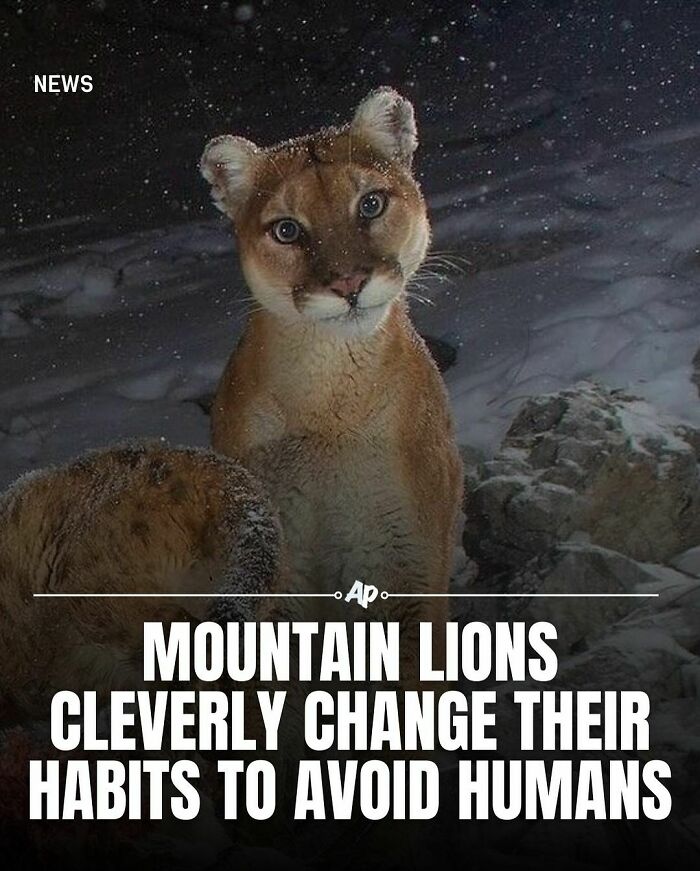
Image credits: an1malpulse
#3
NOTE! The Bird displayed on this picture is not a crow but it’s a Grackle and it was used because of the angry face and it’s a lil bit similar to a crow
Crows never cease to amaze with their incredible intelligence, and it isn’t confined to recognizing threats and holding grudges.
Prior research indicates that crows possess the talent to devise tools and even count.
Stories abound of crows dropping nuts onto busy roads, waiting for cars to crack them open, and then retrieving the food once the traffic stops.
Some crows have even figured out how to use sticks to extract insects from tree bark or fashion hooks from twigs to fish out food from hard-to-reach places.
The study from the University of Washington undeniably contributes to affirming the crows’ place in the intelligence hierarchy among birds.
Crows, it appears, are creatures of memory, holding on to grudges and recalling threats even after a lengthy span of 17 years.

Image credits: an1malpulse
#4
A solitary dolphin in the Baltic Sea appears to be talking to himself, potentially because he’s lonely, according to a new study.
Over 69 days between Dec. 8, 2022 and Feb. 14 2023, the researchers detected 10,833 sounds, including several usually related to communication. These included 2,291 whistles, 2,288 burst-pulses — a rapid series of clicks sometimes associated with aggression — 5,487 low-frequency tonal sounds and 767 percussive sounds. The findings were published in a new study on Oct. 31 in the journal Bioacoustics.
Among these noises, the dolphin produced three distinctive whistles. “Bottlenose dolphins have what are known as signature whistles, believed to be unique to each individual, much like a name,” Filatova said. “If we hadn’t known that Delle was alone, we might have concluded that a group of at least three dolphins was engaged in various social interactions.”
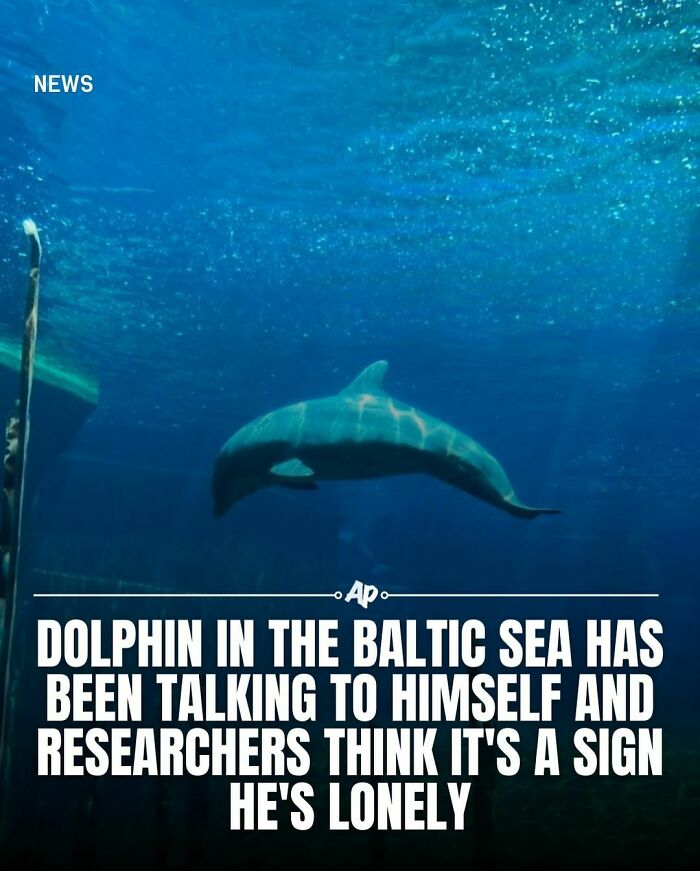
Image credits: an1malpulse
#5
It’s pretty obvious that animals can feel grief. Dogs mourn their owners and each other, and cats mourn the food they were supposed to get 20 minutes ago but didn’t because their human servant tried to sleep in on a Saturday. But one thing that animals don’t do is hold funerals. Cats would probably think it’s sign of personal weakness.
Actually, some animals do hold funerals, and one startling example of an animal that does this is the humble magpie. According to The Telegraph, magpies have been observed engaging in behavior that not only looks like grief, but also a lot like a memorial service. A magpie that encounters the body of another magpie might approach it and peck at it carefully, as if saying, “Frank! Frank! Wake up!” If the body doesn’t respond, the magpie will fly off, and then come back a few minutes later with a few blades of grass, which it will lay next to the body. But researchers haven’t just observed a single bird doing this — other magpies will join in the ritual, each one bringing its own offering of grass. Then the magpies will stand next to the body for a little while before flying away.
This behavior has also been observed in crows and ravens, so not only is it not an anomaly, it isn’t even a behavior that’s confined to a single species. Anthropomorphism rules.
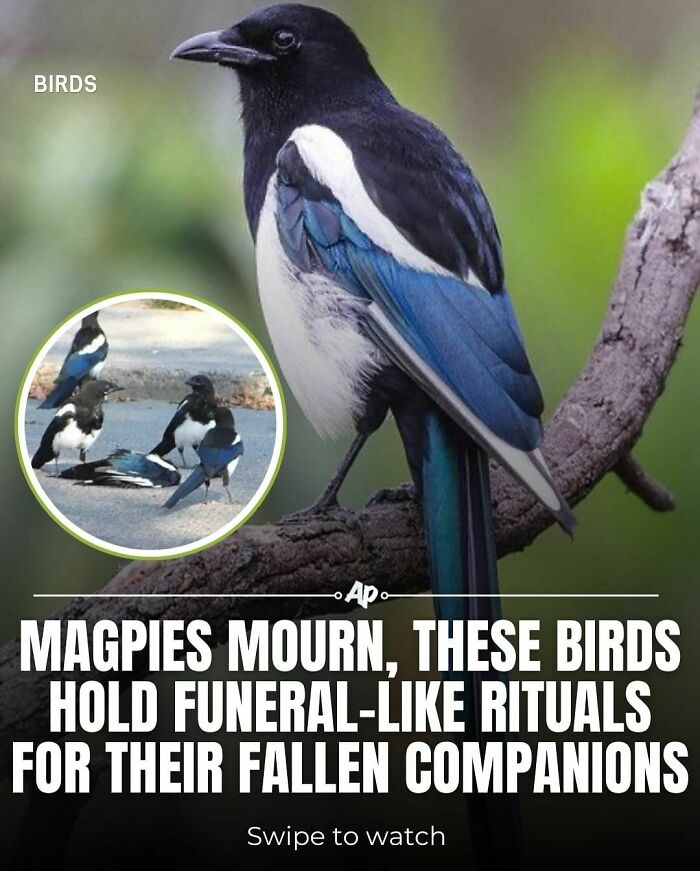
Image credits: an1malpulse
#6
Cats can definitely recognize the sound of words coming from people, and more and more studies prove that cats rely on interaction with humans in problem-solving,” Dr. Carlo Siracusa, a veterinary behaviorist at the University of Pennsylvania, told Live Science. There is even limited evidence that cats can respond to pointing, and research in the past five years has shown that cats can recognize not only their own names but also those of familiar humans and animals. But can they associate words and objects more generally?
To test this theory, Saho Takagi and her team at Azabu University in Japan gave 31 adult cats a simple word game used to investigate the same ability in babies. The cats were shown two nine-second cartoon clips with recordings of their owners repeating a made-up word over each image. The sequence of clips — a red sun labeled “paramo” and a blue unicorn with the word “keraru” — was repeated until the cats appeared to get bored and paid 50% less attention to the screen.
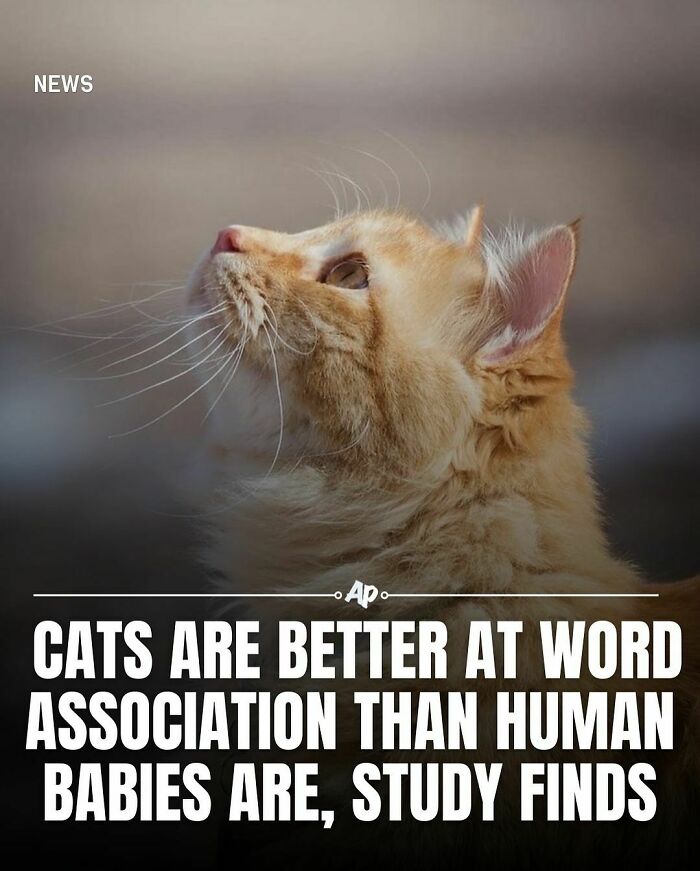
Image credits: an1malpulse
#7
The Japanese flying squirrel is a tiny, nocturnal creature that looks like something out of a fairytale. With its big, round eyes and soft, fluffy fur, this squirrel is irresistibly cute. Its small paws and puffy tail make it look like a living plush toy, while its gliding membrane allows it to effortlessly glide between trees. When perched, its wide-eyed expression and petite size create an endearing sight, making it one of the most charming animals in the wild!
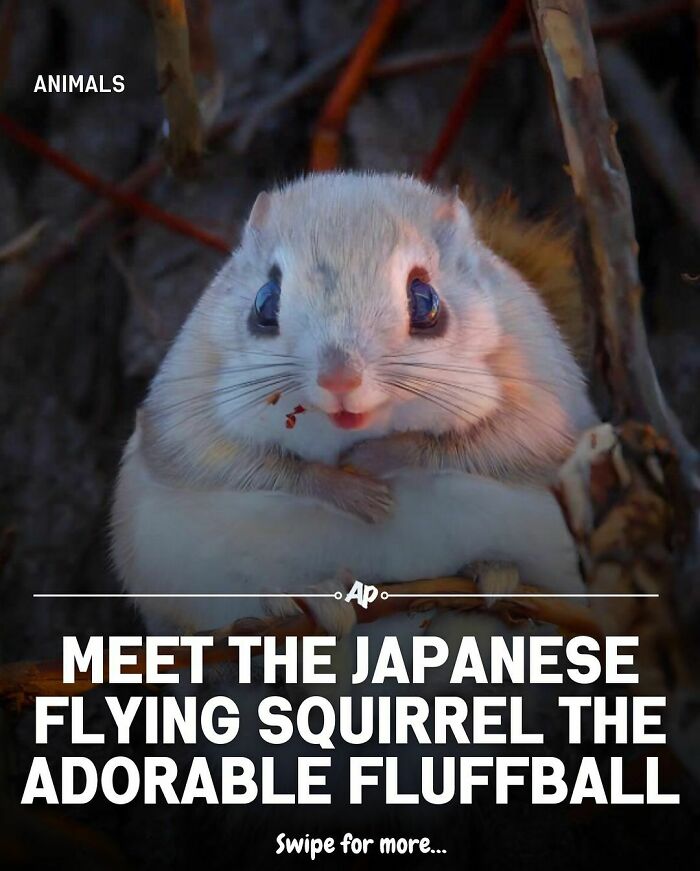
Image credits: an1malpulse
#8
Cats have nine lives — and apparently they have 900 miles in them, too.
Benny and Susanne Anguiano, a couple from Salinas, California, were reunited with their missing cat after he mysteriously traveled that far.
On a trip to Yellowstone National Park in early June, the couple’s beloved house cat Rayne Beau was spooked and ran off into the dense trees.
Distraught, they spent the rest of their trip desperately scouring the forest for him, at times getting lost themselves. They laid out his favorite treats and toys, hoping to lure him back to their campsite.
Benny Anguiano told NBC News that a Yellowstone employee came by their campsite to warn him that a pack of coyotes had attacked a small dog in the area — and that the couple would be lucky if their cat made it through the night. By the time the trip had concluded, Rayne Beau was still missing, Benny Anguiano said.
“We had to leave without him,” Susanne Anguiano said in an interview with NBC affiliate KSBW of Salinas. “That was the hardest day, because I felt like I was abandoning him.”
But as they were leaving Yellowstone, she spotted a special symbol.
“We were driving along and out of nowhere, these double rainbows appear, and it just knit it all together for me,” she told KSBW.
She said she took her cat’s namesake in the sky as a sign to remain hopeful for Rayne Beau’s return. Sixty days later, her wish on the rainbow came true: Her furry friend had been found.

Image credits: an1malpulse
#9
Just imagine a world where humans no longer exist, who would take over? Well, it may not be another mammal. Believe it or not, octopuses could be the ones to dominate Earth after humans.
Scientists have recently made a riveting claim that these eight-limbed, marine invertebrates could become the dominant species on Earth should homo sapiens vanish from existence. It’s an intriguing idea, but how is it possible?
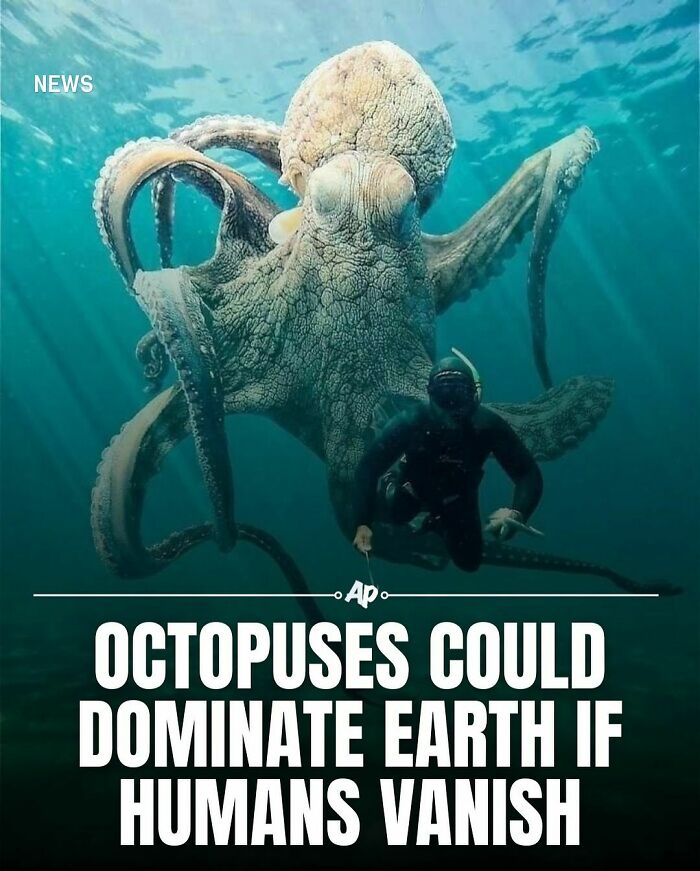
Image credits: an1malpulse
#10
In the depths of the southwest Pacific Ocean, researchers have discovered the largest coral ever documented. Spanning an impressive 111 feet (34 meters) in width, 105 feet (32 m) in length, and standing 18 feet (5.5 m) tall, this colossal organism — so large it’s even visible even from space — resides near the Three Sisters Island group in the Solomon Islands.
The coral, identified as Pavona clavus, is a single, standalone structure, unlike the sprawling networks that typically form coral reefs. Scientists estimate it’s around 300 years old, making it not just a biological marvel that spans the size of two basketball courts, but also a record of centuries of oceanic conditions.
“It is a natural monument that has seen the arrival of the first Europeans to these waters,” San Félix, an underwater cinematographer for National Geographic Pristine Seas who was first to spot the giant coral, said in a statement.

Image credits: an1malpulse
#11
Animal campaigners are calling for a ban on the public sale of fireworks after a baby red panda was thought to have died from stress related to the noise.
The Royal Zoological Society of Scotland, a conservation charity that runs Edinburgh Zoo, said Wednesday that it was likely that Roxie, a 3-month-old red panda kit, “died due to stress caused by fireworks being let off across the city centre.”
Fireworks are set off across the United Kingdom on and around Nov. 5, known as Bonfire Night or Guy Fawkes Night, in celebration of the failure of a plot to blow up the Houses of Parliament by a group of dissident Catholics in 1605.
The tradition is centuries old and unique to the U.K., with some towns creating huge elaborate effigies of Guy Fawkes to be burned — sometimes instead building models of contemporary figures, including former prime ministers Boris Johnson and Rishi Sunak.
But animal rights campaigners and pet owners have long complained that the noise causes extreme distress to animals.
The zoological society said that the red panda’s mother also died just five days earlier and that her death could also be related to fireworks noise.

Image credits: an1malpulse
#12
Margays are small, wild cats that live in the evergreen and deciduous forests of Central and South America. They live primarily in trees and use their long, heavy tails for balance.
Mostly nocturnal, Margays hunt in trees and eat birds, eggs, fruit, and small mammals. Female Margays produce a litter of only one kitten every two years. This, along with the fact that Margays have been hunted for their coats, makes these majestic cats endangered.
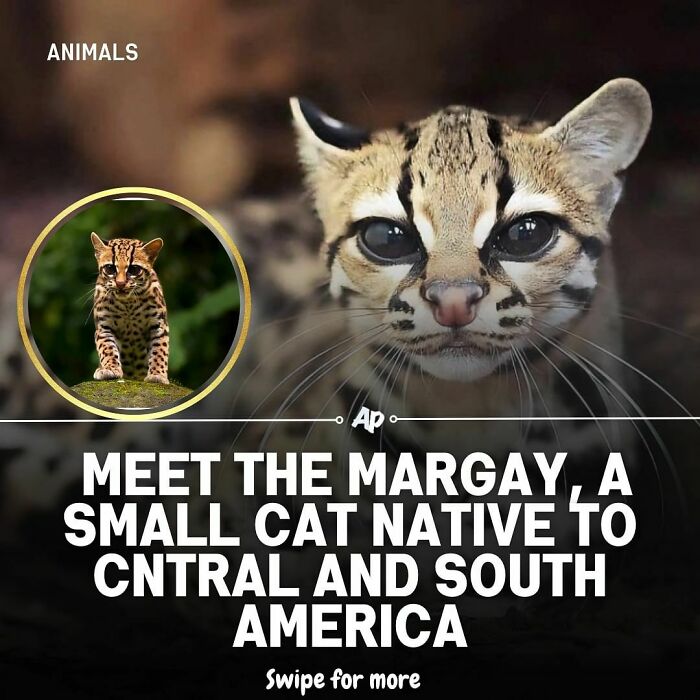
Image credits: an1malpulse
#13
New Zealand’s birds must love the ground. The round-faced kākāpō, also known as an owl parrot, is another species of endemic flightless bird, the only flightless parrot on Earth. It’s wings help with balance and to ‘parachute’ when jumping from tall trees to the forest floor. The birds are known to freeze when they feel threatened, to blend into the forest greenery and escape predators. Māori and European settlers used to keep the birds as pets. They’re now listed as Critically Endangered, largely due to habitat loss and predatory invasive species.
Where to see? The small number of remaining kākāpō exist on a handful of predator-free, sanctuary islands, under close supervision, mostly near Stewart Island, Fiordland and Little Barrier Island in the Hauraki Gulf. The general public’s currently unable to view this species in the wild, due to restrictions on protected habitats.
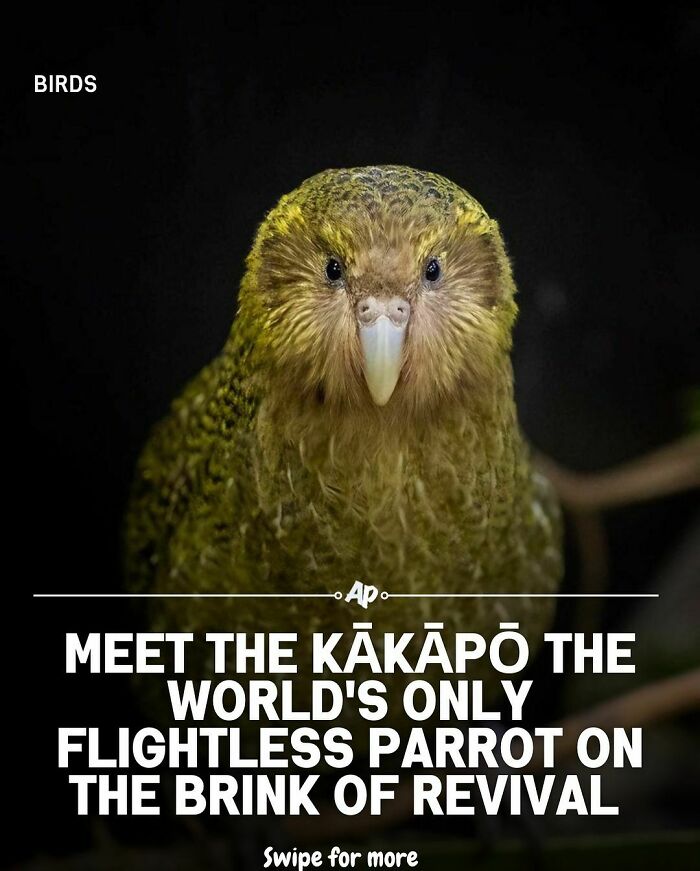
Image credits: an1malpulse
#14
Researchers have pulled the mummy of a newborn saber-toothed cat that died at least 35,000 years ago from Siberia’s permafrost — and the kitten still has its whiskers and claws attached.
A new analysis of the kitten’s stunningly-preserved head and upper body shows it was just 3 weeks old when it died in what is now Russia’s northeastern Sakha Republic, also known as Yakutia. Scientists found pelvic bones, a femur and shin bones encased in a block of ice together with the mummy. The circumstances of the animal’s death are unknown.
It is extremely rare to find well-preserved remains of saber-toothed cats, and this one belongs to the species Homotherium latidens, according to a study published Thursday (Nov. 14) in the journal Scientific Reports. Saber-toothed cats of the extinct genus Homotherium lived across the globe during the Pliocene (5.3 million to 2.6 million years ago) and early Pleistocene (2.6 million to 11,700 years ago) epochs, but evidence suggests this group became less widespread toward the end of the Pleistocene (also known as the last ice age).
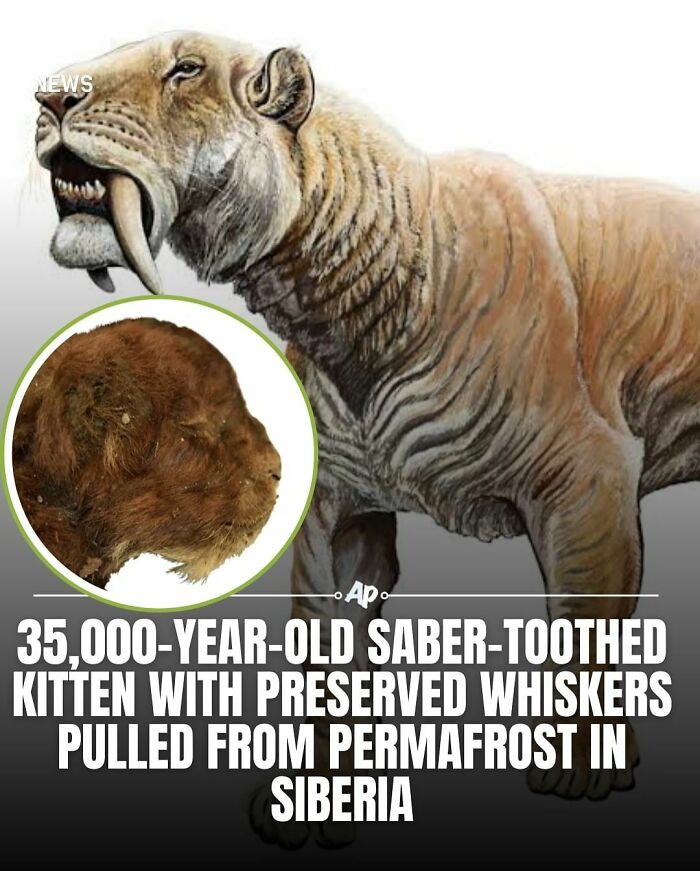
Image credits: an1malpulse
#15
If there is one fish that roams the freshwaters of Africa that is to be feared above all others, it is the goliath tigerfish. Thought to be a cousin of the piranha, the goliath tigerfish has inspired fear among the locals of the dangerous Congo River where it dwells. Though it lurks on the murky depths, the sight of one of these fish is likely to send you paddling back to shore in a hurry. With massive jaws and teeth capable of ripping anything to shreds, these river monsters are the only known African freshwater fish that has attacked people.
Accounts vary, but as a story from the Animal Planet show “River Monsters,” goliath tigerfish will attack out of nowhere, leaping out of the water and sinking their enormous teeth into a person. According to the Daily Mail, these fish are fearless and will routinely attack, and eat, foe that are far bigger than it, such as crocodiles.
Any sporting angler who is fishing on the Congo River will need to be wary of hooking one of these fish. Their brute strength combined with their ferocity make them a formidable challenge. If you do not know what you’re doing when you catch one, you could end up bloodied and wounded.
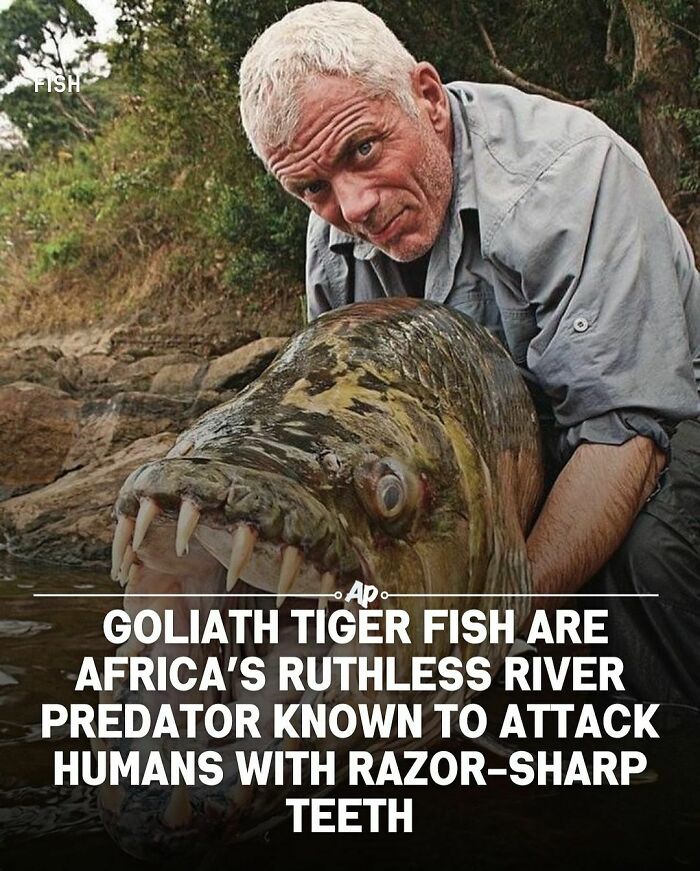
Image credits: an1malpulse
#16
The leaf sheep sea slug (Costasiella kuroshimae), also known as the “leaf slug,” is a tiny, adorable marine creature that resembles a cartoon sheep with leafy “ears.” Found in waters around Japan, the Philippines, and Indonesia, it’s famous for its unique ability to perform photosynthesis, a process more common in plants. The leaf sheep feeds on algae and absorbs the chloroplasts from it, allowing the slug to harness energy from sunlight – a rare ability called kleptoplasty. Its vibrant, green leaf-like appearance and cute features make it popular among marine enthusiasts and on social media.
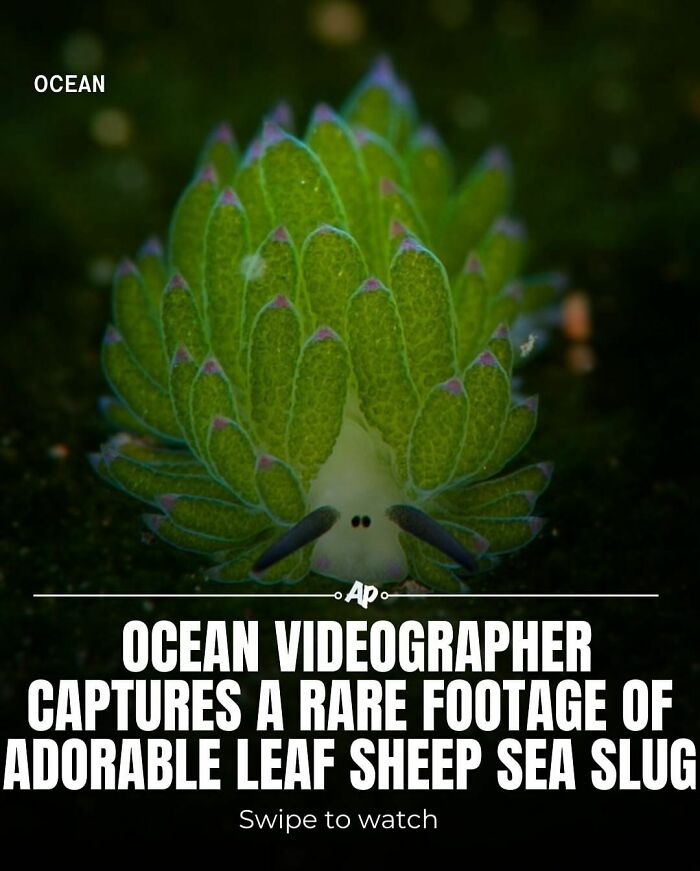
Image credits: an1malpulse
#17
A man whose dog was attacked and dragged away by a Siberian tiger followed the predator’s tracks to find his pet — only to be attacked and k*lled by the tiger in a forest in eastern Russia, officials said Monday. The body of the man, who was not identified, was found with signs of an animal attack in the remote Khabarovsk territory, regional police said. According to the Amur Tiger Center, the big cat attacked a dog owned by a resident of the village of Obor, prompting the owner to track the animal “for a considerable distance.” Eventually, the pet’s owner came across the predator near its prey in the forest. “Presumably, the animal regarded this as a threat” and fatally attacked the man, the center said. The man was found dead near the remains of his dog, officials said.
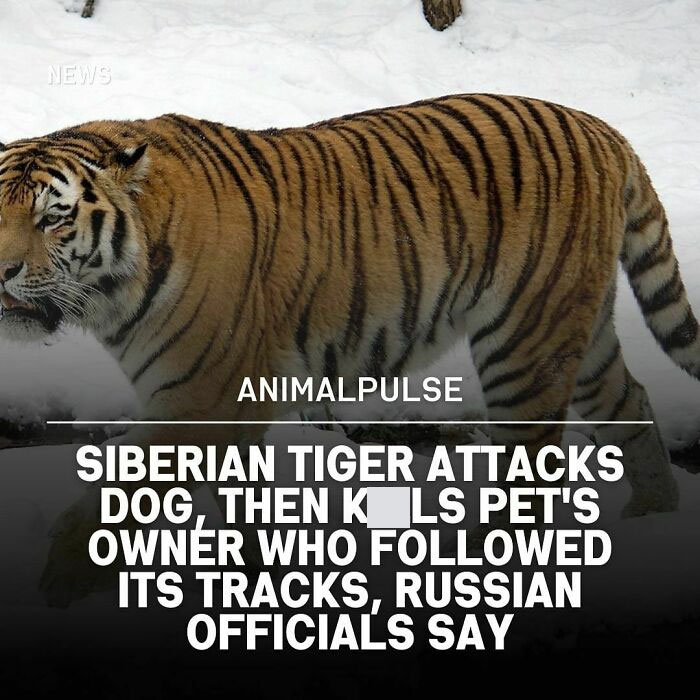
Image credits: an1malpulse
#18
When you hear about Sgt. Stubby’s accomplishments, it’s hard to deny that he’s worthy of his title. Per the Smithsonian’s National Museum of American History, in 1917, Stubby was found wandering the grounds of Yale University, where the 102nd Infantry was training. The regiment adopted Stubby, and he quickly became their mascot, boosting morale with tricks like saluting with his paw. When the division shipped out for France, Pvt. J. Robert Conroy smuggled the dog onto their ship. Conroy’s commanding officer discovered Stubby, but he allowed him to stay when the dog gave him a salute.
But Stubby’s contributions weren’t limited to simple tricks. In February 1918, Stubby followed the 102nd Infantry to the front lines, where he became acutely familiar with the smell of gas. One morning, while the soldiers were sleeping, Stubby smelled a gas attack and roused the regiment with barks and bites, likely saving their lives. Later, Stubby would help locate wounded soldiers on the battlefield. At one point, Stubby even helped his regiment capture a German spy, biting the German’s legs and making him fall over.
For his contributions, Stubby was awarded the rank of sergeant, making him the first dog to be given rank in the United States Armed Forces, per the Smithsonian. In the years after World War I, Sergeant Stubby met several U.S. presidents and received many awards. He died in 1926, and his taxidermied corpse is held in the National Museum of American History.

Image credits: an1malpulse
#19
In January 1925, doctors in the isolated Alaskan city of Nome saw signs of an impending diphtheria outbreak. The nearest anti-diphtheria serum was 500 miles away in Anchorage. At the heart of winter, getting the serum seemed all but impossible. In such thick snow, only sled dogs could make the journey. Volunteers set up a relay of sled teams to make the journey as quick as possible, called the ‘Great Race of Mercy‘. The final stage of the journey saw Gunnar Kaasen and his lead dog, Balto, arrive in Nome in the nick of time, saving the city from deadly disease.

Image credits: an1malpulse
#20
A wildlife center has developed a way of stopping an abandoned newborn red fox from becoming too used to humans: By feeding it wearing a fox mask.
The Richmond Wildlife Center in Richmond, Virginia, shared a video of the center’s founder, Melissa Stanley, feeding milk to the tiny female kit — the term for a juvenile fox — while wearing the mask in an attempt to prevent imprinting, where animals form a strong bond shortly after birth with the first other animal it receives care from.
“It’s important to make sure that the orphans that are raised in captivity do not become imprinted upon or habituated to humans,” the center said in a Facebook post Tuesday.
“To prevent that, we minimize human sounds, create visual barriers, reduce handling, reduce multiple transfers amongst different facilities, and wear masks for the species,” the update said.
The center added that it was able to find other fox kits the same age and weight as the rescued fox.
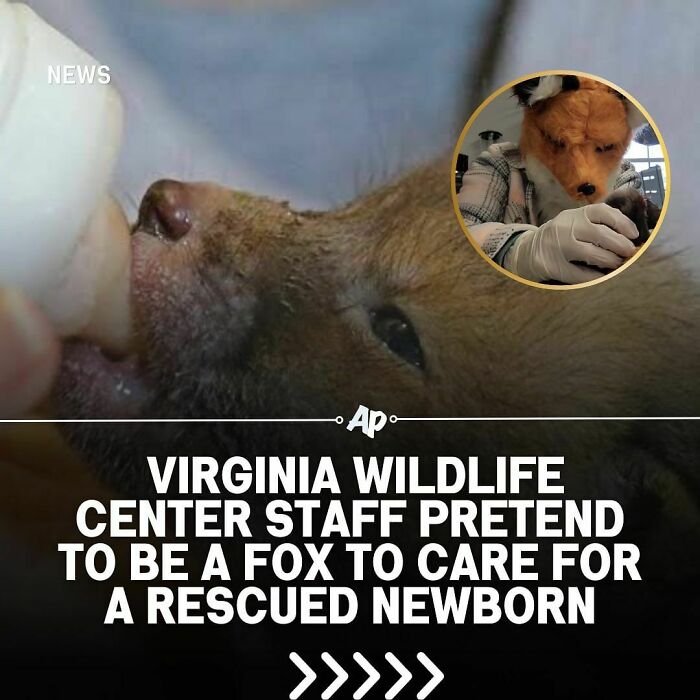
Image credits: an1malpulse
#21
For the first time, transcriptomes — essentially the complete sets of RNA transcripts from an organism — have been reconstructed for an extinct species, providing unprecedented insights into the biology of the Tasmanian tiger.
Emilio Mármol, the study’s lead author and a dedicated researcher at SciLifeLab, underscores the importance of this venture .
“Resurrecting the Tasmanian tiger or the woolly mammoth is not a trivial task and will require a deep knowledge of both the genome and transcriptome regulation of such renowned species, something that only now is starting to be revealed,” he enthused
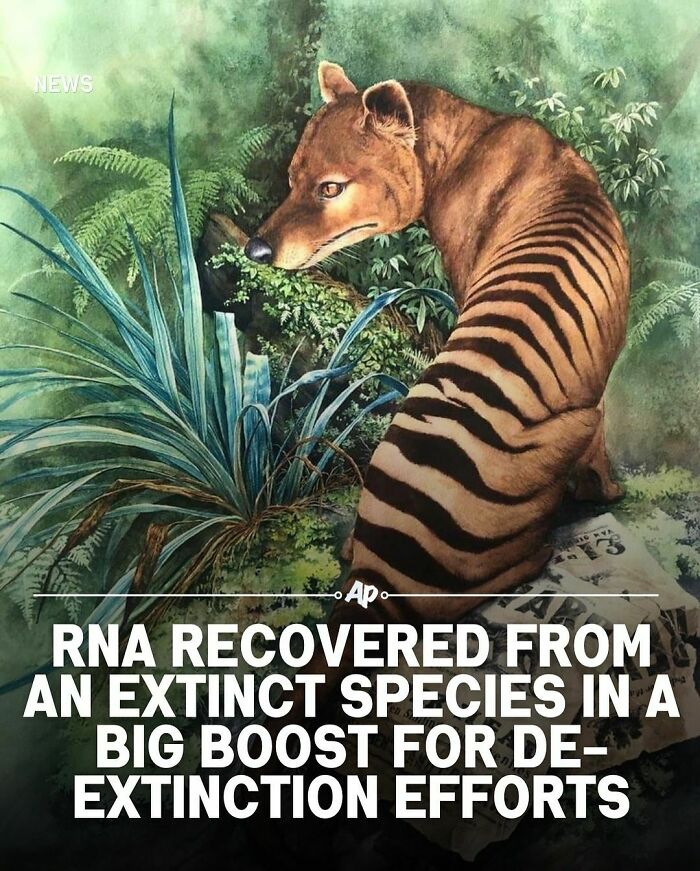
Image credits: an1malpulse
#22
The Ashera cat is considered the most expensive cat breed in the world, with prices reaching up to $100,000 or more. This is due to its rarity and the fact that it is a hybrid breed, created by breeding an African serval, an Asian leopard cat, and a domestic house cat. The Ashera cat is known for its wild, exotic appearance and large size, and is considered a status symbol among cat lovers. Additionally, due to the breeding process, the breeding of Ashera cats is not very common and is only done by a few breeders, which also contributes to its extremely high cost.

Image credits: an1malpulse
#23
The African black-footed cat is not a danger to people, or even to wildebeests, gazelle, or jackrabbits, but birds fear it and rats tell stories about it to their children to make them behave. According to Smithsonian, the African black-footed cat is officially the world’s deadliest cat by prey count, it’s just that its prey thankfully does not include us. Black-footed cats are Africa’s smallest cats, in fact at 2 ½ to 4 pounds, they are smaller than the average house cat by more than half. They are also really, really cute — they don’t look much different from a long-haired domestic tabby cat, except they’re small so there’s that extra “aw” factor. But alas, a black-footed cat isn’t going to jump on your lap and make biscuits, because that’s not how it rolls. A single black-footed cat can dispatch between 10 and 14 rodents or birds in a single night, and they have a k*ll success rate of about 60%, which is about three times the success rate of a typical lion. Sorry, so-called “king of the beasts.” What could a single cat possibly want with all those dead rodents and birds? Well, they usually put their heads on spikes as a warning to all the other rodents and birds. Just kidding. The black-footed cat has an extra-fast metabolism, so it literally needs to be constantly hunting and eating just to keep its adorable little body going.

Image credits: an1malpulse
#24
King Philip (1116-31) ruled France with his father, Louis the Fat (c.1081-1137). Like many teenagers, he refused to listen to his dad, or anyone else, really. One day, as he rode his horse along the River Seine in Paris, a little black pig ran out from a dung heap. Philip’s horse tripped over it and crashed to the ground. Philip hit his head, and never regained consciousness. Louis VII succeeded Philip and helped launch the Second Crusade, in which many thousands of people died horribly. If only that ruddy pig had stayed put in the dung heap
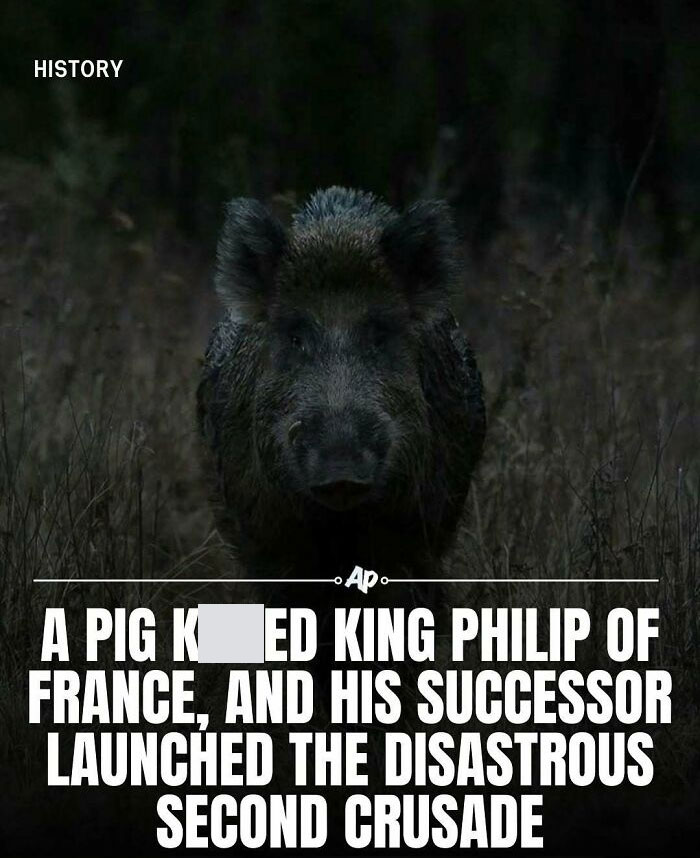
Image credits: an1malpulse
#25
The old English proverb “you can lead a horse to water, but you can’t make it drink” has been used since the 16th century to describe the difficulty of getting someone to act in their own best interests.
Now, research by equine scientists suggests the use of this phrase has been inadvertently maligning horses for centuries.
Horses have the ability to think and plan ahead and are far more intelligent than scientists previously thought, according to a Nottingham Trent University study that analysed the animal’s responses to a reward-based game.
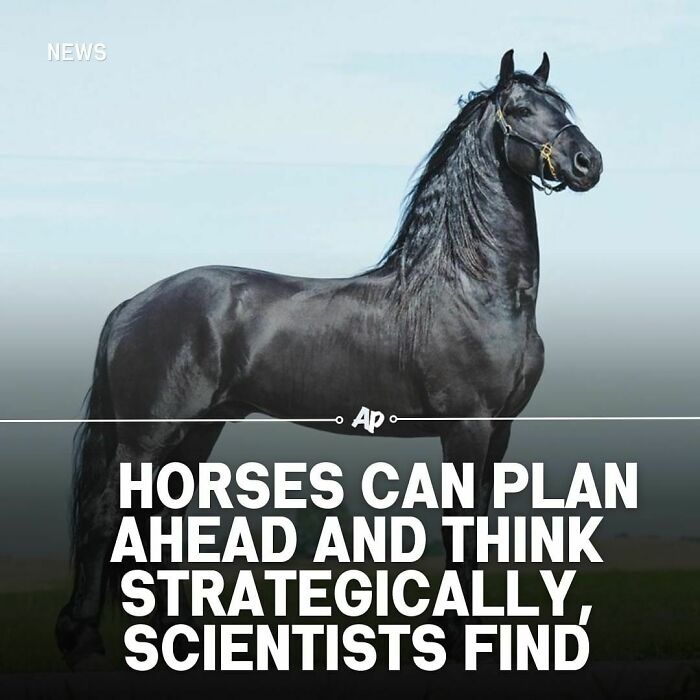
Image credits: an1malpulse
#26
According to Oceana, crocodiles and related species have a PR problem: If you were to encounter them face to face, they’d probably be just as unhappy (and eager to get away) as you. However, that’s not the case with the saltwater or estuarine crocodile, a species with a well-documented history of territorial aggression against humans. Hardly surprising, considering that it chomps down with a force of nearly 17,000 newtons, the strongest bite force ever measured of any living land animal. For perspective, that’s one-fourth of the car-crushing bite force of a Tyrannosaurus rex (via Business Insider).
Active year-round, saltwater crocodiles are found across Australia, from northern coastal areas and drainages to islands about 60 miles from the mainland (via the Australian Museum). While it can survive in seawater, these reptiles prefer living in brackish (somewhat salty) water. National Geographic describes this 23-foot, 2,200-pound carnivore as a “classic opportunistic predator” that snacks on just about anything unfortunate enough to pass by their territory: birds, sharks and other large fish, water buffalo, wild boars, monkeys, and even humans. Few prey can survive a surprise attack from the world’s largest reptile: It waits patiently under the water’s surface until it spots its next target, after which it comes out of hiding while thrashing its enormous tail. It quickly nabs its shocked prey, drowning it before turning it into lunch. Also, wounds from crocodile attacks tend to get infected, requiring prompt antibiotic treatment.
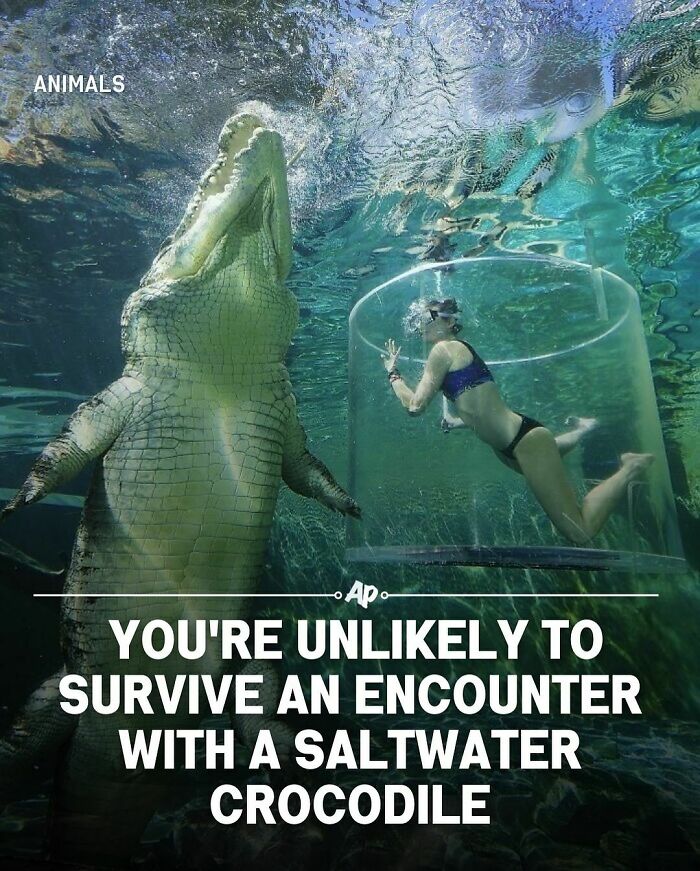
Image credits: an1malpulse
#27
when thinking of predators ideally suited to chowing down on human life, raptors might top the list. That’s because they’re smaller, faster, leaner, capable of squeezing into spaces that would bar larger creatures, and — as paleontologist Cassius Morrison says on Business Insider — might have even climbed trees. Funny enough, the closest modern comparison to raptors may be ostriches, which can disembowel a person with a single kick — just like raptors could with their foot claws. “Raptor,” in fact, is a catch-all term for numerous species of a particular variety of feathered reptile. Some were as small as a chicken and might gnaw your leg off, while others weighed 500 pounds and might tear apart your head. They survived all the way from 145 to 65 million years ago and only died off when the asteroid Chicxulub struck Earth. The rocky celestial body k*lled off the dinosaurs and put an end to all of this megafaunal nonsense by paving the way for apes like us, bereft of natural defenses. We’re sad to report, however, that velociraptors — featured in “Jurassic Park” — were actually chicken-sized and probably kind of dumb. Not that it would matter much if one of them lunged at your throat.

Image credits: an1malpulse
#28
An 18-foot Australian crocodile that held the world record as the largest crocodile in captivity has died, a wildlife sanctuary said Saturday. He was thought to be more than 110 years old.
Cassius, weighing in at more than one ton, had been in declining health since Oct. 15, Marineland Melanesia Crocodile Habitat said on Facebook.
“He was very old and believed to be living beyond the years of a wild Croc,” according to a post by the organization, based on Green Island near the Queensland tourist town of Cairns.
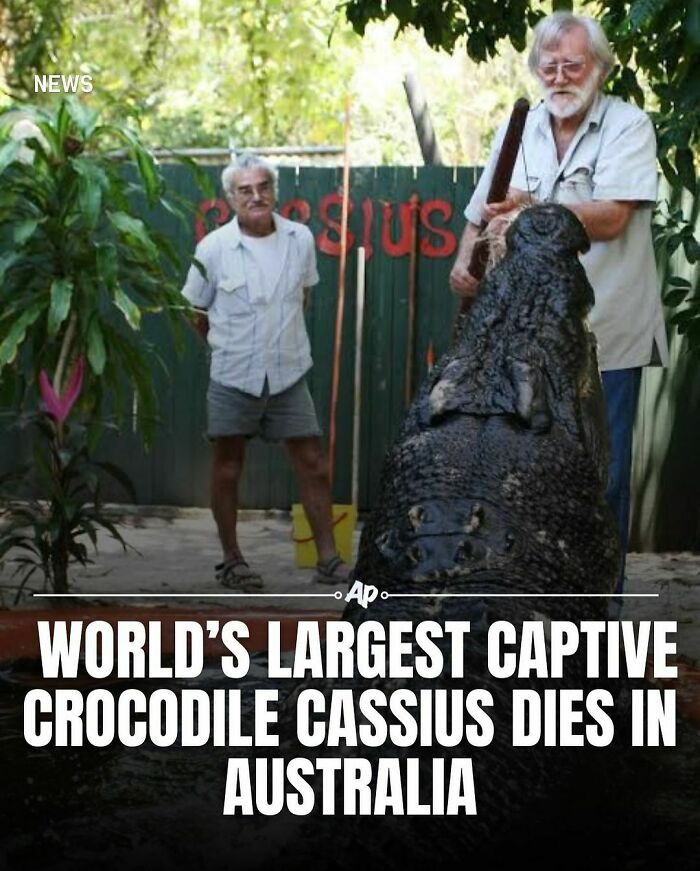
Image credits: an1malpulse
#29
Though his feathers are changing now, Pesto’s beak will remain pure black for the next two years, until he hits sexual maturity. Then, he’ll get elongated orange spots on either side of his bottom beak, a characteristic of adults.
Pesto was born in late January, which makes him about 9 months old. His birth was a big deal for the aquarium, which didn’t have any king penguin chicks hatch in 2023. He was also the only king penguin to hatch in 2024.
When he was born, Pesto weighed less than half a pound. But as he got older, he began to rapidly balloon in size, eventually tipping the scales at 50 pounds. For comparison, adult king penguins usually weigh between 31 and 37 pounds. Pesto is the biggest chick Sea Life Melbourne has ever had.
The aquarium put Pesto on public display in April. But it wasn’t until staffers held a gender reveal party in September that the massive baby bird became a worldwide celebrity.
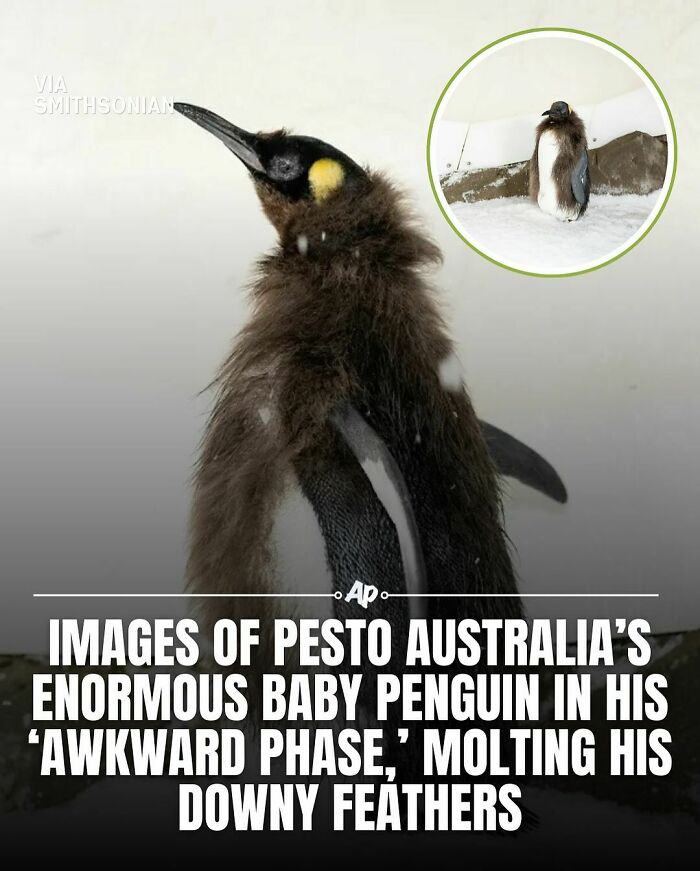
Image credits: an1malpulse
#30
Koi, or Nishikigoi, are ornamental varieties of the common carp and hold immense cultural significance in Japan. Their vividly colored scales and elegant swimming patterns have earned them the title of “living jewels” or “swimming flowers”.
In 2018, a wealthy collector from Taiwan acquired a unique Koi, christened “S Legend,” for an astounding $1.8 million at an auction in Japan. This beautiful and rare 3-feet long red Koi was the most expensive ever sold, illustrating the high value associated with these symbols of love and friendship.

Image credits: an1malpulse
#31
The inland taipan is quite possibly the most venomous snake in the world, but that doesn’t necessarily mean it’s the most dangerous snake in the world. A resident of Australia, the taipan is actually very shy, rarely seen, and during the day, it’s only active during a very short period of time. It also lives in a remote part of Queensland, where not a lot of people go, so it’s not like you have to worry that you’re going to find one curled up in your shoe or anything. In fact, snake experts say it’s quite docile to handle, so they can just go ahead and do that, then. If you do get bit by an inland taipan, though, you’re probably going to be in trouble. According to the Australian Museum, this snake’s venom contains a “spread factor,” which actually helps your body to absorb it faster, so that’s awesome. And one bite contains enough venom to k*ll 100 human beings. But on the flip side, only a few people have ever been bitten, and they were able to receive prompt medical care, so they all survived. In other words, this snake is something of a novelty on this list. It’s possibly the most lethal serpent in the world, but so far, it hasn’t ever actually been lethal to anyone (that we know about).

Image credits: an1malpulse
#32
While the Greenland shark (Somniosus microcephalus) may not have the same fame as the great white shark, it holds an impressive distinction: it is the longest-living vertebrate species known to science. These remarkable sharks can live for up to 400 years, surpassing the previous record-holder, the bowhead whale, which can reach around 211 years. A Greenland shark alive today could have been swimming the oceans as far back as the 1600s — more than four centuries ago!
Despite their ancient existence, the Greenland shark was only recently recognized as the longest-living vertebrate, primarily because scientists had long struggled to determine its age. Unlike most sharks and other vertebrates, which have hard tissues like spines that form growth rings (much like the rings inside a tree trunk), Greenland sharks lack these structures, making age estimation a challenge. It wasn’t until Danish scientists stumbled upon a breakthrough involving human cadavers and some forensic ingenuity that the mystery of the shark’s age was finally unravelled.
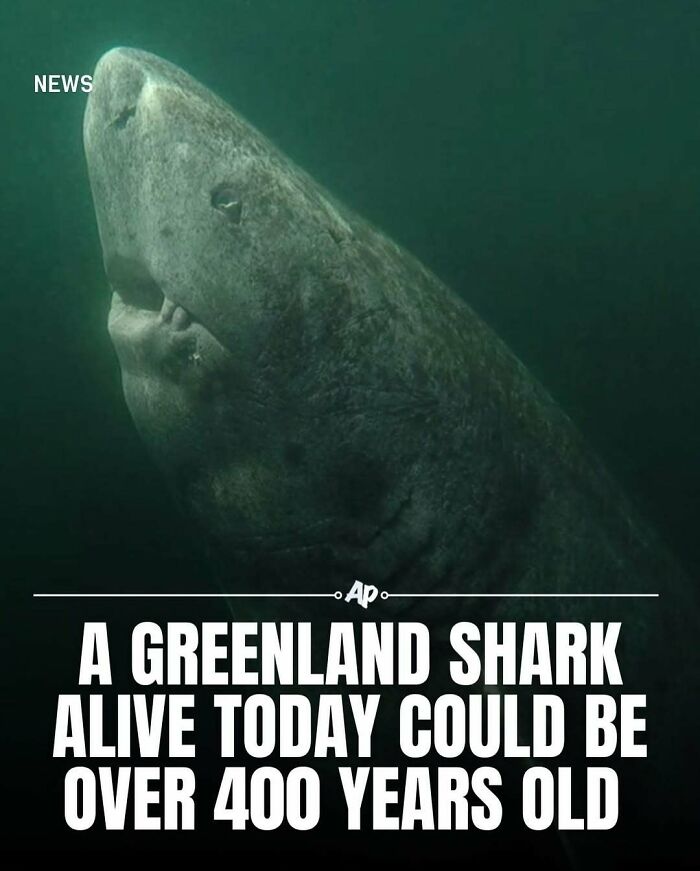
Image credits: an1malpulse
#33
An angry-looking myna bird has become a viral video star after landing directly in front of a highway traffic camera in New Zealand.
The black-and-yellow tropical bird stares curiously into the camera overlooking a section of road near Auckland, New Zealand’s largest city, its beak open as it appears to squawk loudly. It then flies off before returning for a few more seconds.
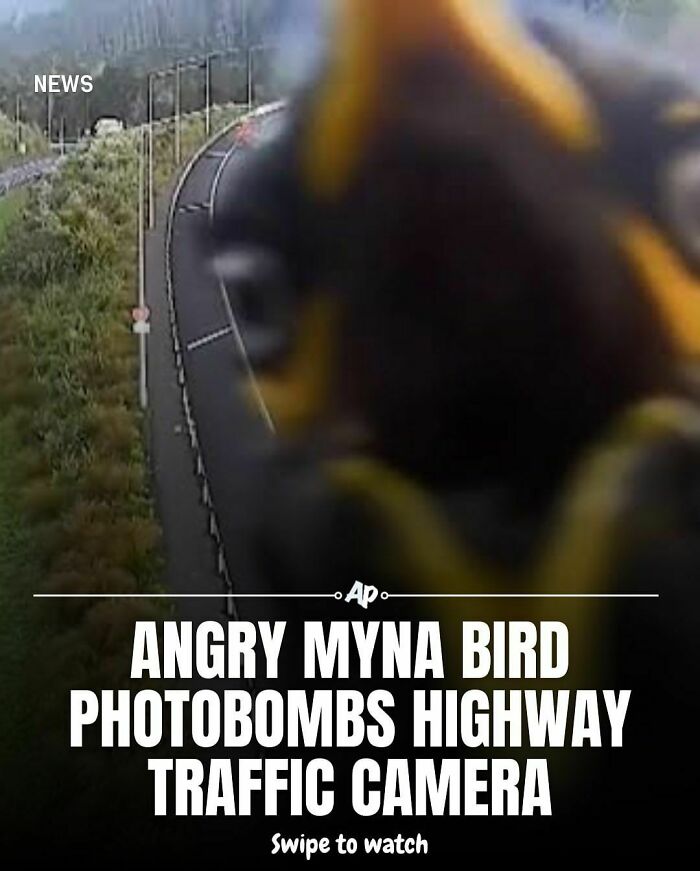
Image credits: an1malpulse
#34
The tarsier’s an animal that seems to be taking the phrase ‘eyes bigger than your stomach’ as a literal challenge. The little, leaping primates have massive eyes, long, thin alien-like fingers and heads that rotate like they’re auditioning for a part in a remake of The Exorcist. Sadly, their cuteness has made them popular over the years as pets or as props forced to pose for tourist photos, causing them distress.
Where to see one? The International Union for Conservation of Nature (IUCN) lists more than a dozen species of tarsier across South-East Asia, including the Philippines, Malaysia and Indonesia, several of which are Endangered or Critically Endangered. Bohol in the Philippines is a good place to see tarsiers; try one of the local sanctuaries, such as Tarsier Conservation Area.
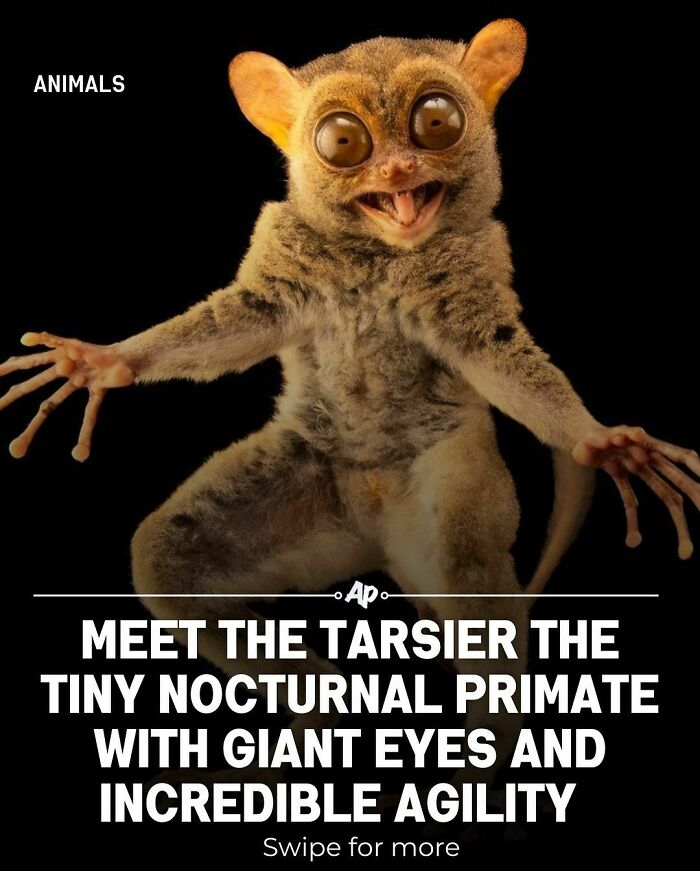
Image credits: an1malpulse
#35
In a refreshing attempt to understanding animal consciousness and emotions, a group of researchers from various disciplines have come together to share their thoughts.
The research team was led by Dr. Marcela Benítez, assistant professor of anthropology at Emory University.
“As far as we know, this is the first assessment of how animal behavior researchers across a range of disciplines think about emotions and consciousness in non-human animals,” said Professor Benítez.

Image credits: an1malpulse
#36
Research sheds light on how coyotes, North America’s most successful predators, are responding to various environmental pressures, including human development, hunting and competition with larger carnivores. Surprisingly, the study’s findings suggest that human hunting practices may actually contribute to increasing the number of coyotes.
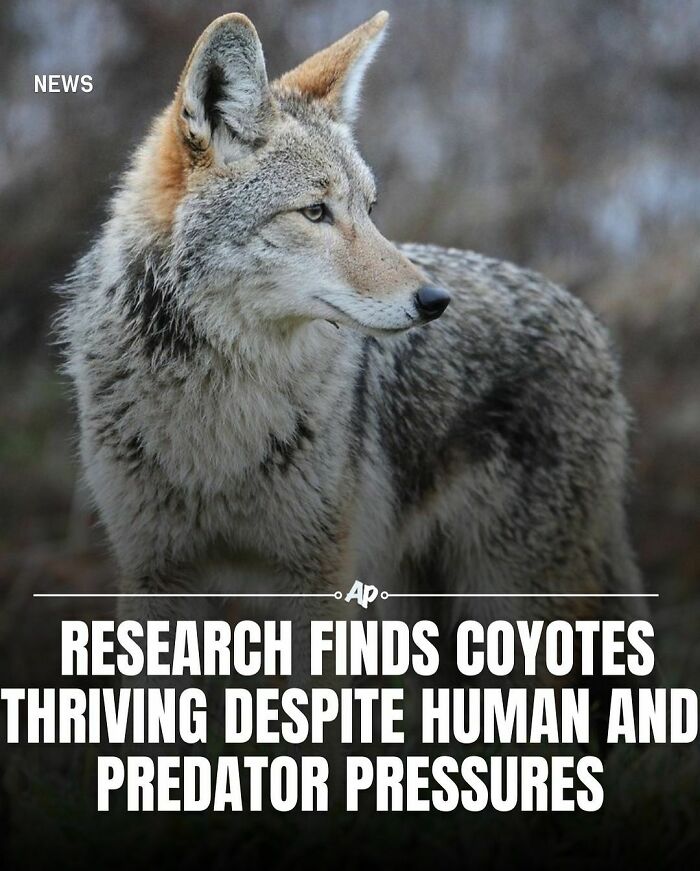
Image credits: an1malpulse
#37
Scarlet macaws are a symbol of fidelity and virtue to many people because they are thought to mate for life—but it turns out that they also “play favorites” when feeding their young, making them excellent mates, but neglectful parents.
Fortunately, Texas A&M scientists have developed a way to ensure the birds’ bad parenting results in fewer chick deaths.
Researchers at the College of Veterinary Medicine and Biomedical Sciences have discovered that scarlet macaws purposefully neglect feeding the youngest chicks in most broods, even when resources are plentiful. This results in only one or two chicks being able to fledge—the process in which parents teach their young to fly and survive on their own—even though broods may contain up to four chicks.
“Scientists have known for years that scarlet macaws hatch more chicks than they fledge,” said Dr. Donald Brightsmith, a professor in the VMBS’ Department of Veterinary Pathobiology. “We found that 26% of second chicks in scarlet macaw broods and nearly all third and fourth chicks die before fledging.
“We tested several theories as to why these younger chicks don’t survive, and we found that it’s not sibling rivalry or a lack of food. The parents just stop feeding certain chicks, so they starve to death,” he said.
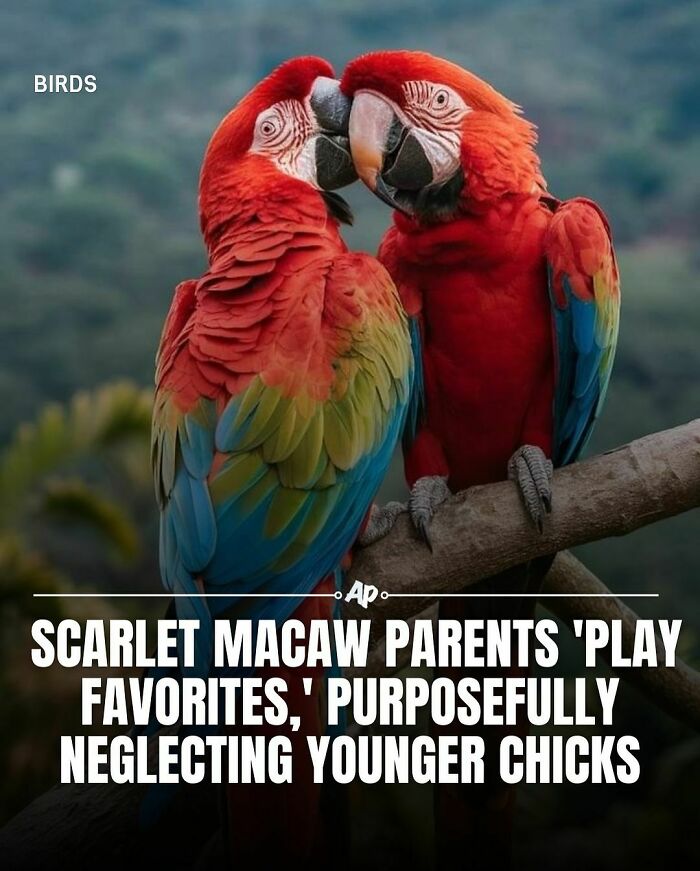
Image credits: an1malpulse
#38
In response to the outcry, New York Assemblyman and animal advocate Jake Blumencranz introduced “Peanut’s Law: The Humane Animal Protection Act.” This proposed legislation seeks to reform the process of animal seizure and euthanasia by requiring authorities to provide advance notice and allow an appeal before euthanizing animals taken from sanctuaries or private homes. The law aims to ensure fairer treatment and a more compassionate approach for animals like Peanut, who have lived with humans for years.
“I’ve called on Governor Kathy Hochul and the New York State Department of Environmental Conservation for a FULL investigation into this tragedy which resulted in the death of @peanut_the_squirrel12 and Fred the Raccoon, and l’ve just introduced “Peanut’s Law: Humane Animal Protection Act” to protect sanctuary animals like them and ensure that this never happens again. We must protect every animal and animal sanctuary like @nuts_freedom_farm,” shared Blumencranz on Instagram.
To support this important legislation, please reach out to your state lawmakers and emphasize the importance of humane laws for wildlife like Peanut and Fred.
After rescuing Peanut, Lango was inspired to open his own rescue, P’Nuts Freedom Farm Animal Sanctuary, which opened in April 2023. The sanctuary now houses about 300 animals, including horses, goats, and alpacas. Lango runs the sanctuary with his wife, Daniela, and other family members.

Image credits: an1malpulse
#39
In 1958, Chairman Mao waged war on an unlikely enemy. Noticing that tiny sparrows frequently stole a little bit of grain, he saw an opportunity to increase grain production. ‘Birds are public animals of capitalism’ roared Mao’s government, launching a campaign to exterminate them. Professional hunters and ordinary folk alike chased sparrows, leading many birds to die of exhaustion. People destroyed their nests and smashed their eggs. Unfortunately, Mao didn’t realize sparrows also ate insects that did far more damage to agriculture. The resultant ecological imbalance exacerbated the Great Chinese Famine, which k*lled between 15 and 45 million people.

Image credits: an1malpulse
#40
A malnourished emperor penguin appeared on a beach in Australia, thousands of miles from its home in Antarctica. Wildlife experts rescued the bird and took it to a rehabilitation center.
A beachgoer at “a popular tourist beach in Denmark, Western Australia,” noticed the out-of-place emperor penguin on Friday, Nov. 1 and alerted wildlife experts, the region’s Department of Biodiversity, Conservation and Attractions said in a news release shared with McClatchy News on Nov. 8.
Carol Biddulph, an “experienced local seabird rehabilitator,” arrived to check on the lost penguin. Photos show the 3-foot-tall black and white bird standing on the sandy beach.
“The bird sort of turned at an angle and I could see its backbone protruding and I thought this bird is well undernourished,” Biddulph said in an interview shared with the release. “Between the condition of the bird and the activity that might have happened on the beach the following day, I thought it was best to bring the bird in.”
“Getting it back to the car was quite a challenge,” she said. “We got it into a carrier, a large canvas pet carrier, nice and soft, and got it into the car.”
Biddulph took the bird home to her “dedicated penguin enclosure,” she said. There, the penguin was weighed and treated. A local vet and department officials also helped with the animal’s care.
“I’ve never had to deal with a large penguin like this before,” Biddulph said. “They’ve always been a lot smaller—our local little penguins.”
Emperor penguins are the world’s largest penguins, known for their iconic looks and “stately demeanor,” according to Britannica. They typically live on the ice shelves of Antarctica, thousands of miles from Australian beaches.
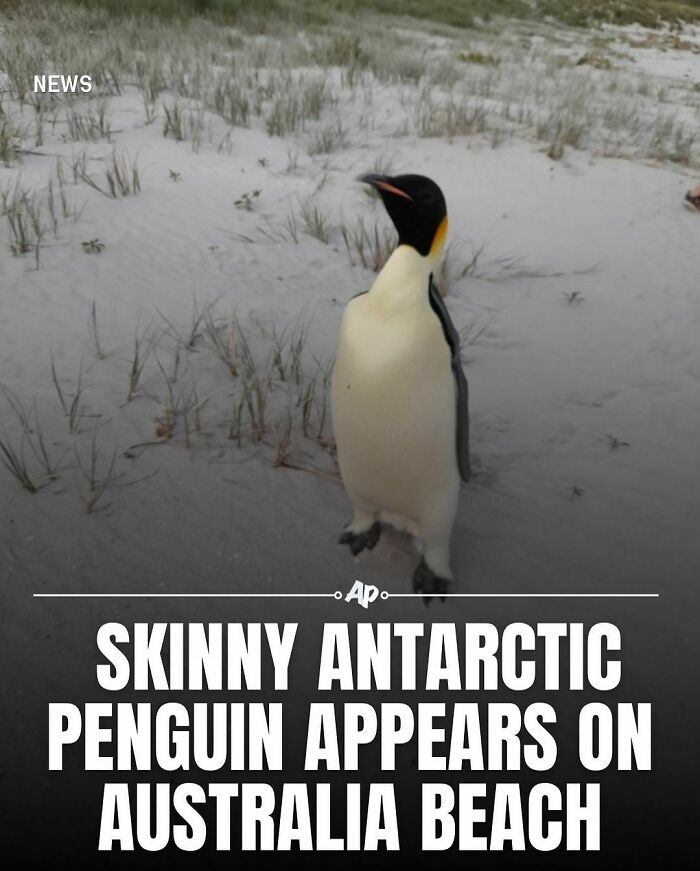
Image credits: an1malpulse
#41
Petco has recently announced the implementation of a new adoption-only policy for rabbits, acknowledging their status as the third-most popular companion animal in the U.S.
As a result of this progressive step, Petco is ending its prior limited pilot program that allowed the sale of commercially bred rabbits. This positive shift underscores Petco’s dedication to fostering connections between caring families and pets in need of loving homes.
“Petco is doing right by rabbits by recommitting to an adoption-only policy. We celebrated the company’s decision years ago to commit to a humane business model that offers adoptable cats and dogs instead of puppies and kittens from massive commercial breeding operations,” said Kitty Block, president and CEO of the Humane Society of the United States (HSUS).
“Adding rabbits to this policy reflects a commitment to animal welfare and sets an example for other retailers,” continued Block. “There’s simply no need for puppy, kitten, or rabbit mills when there are already so many wonderful adoptable companions in need of homes.”
HSUS has been at the forefront of the movement to end puppy sales in pet stores, with eight states and over 475 localities now prohibiting such sales, many of which also include kittens and rabbits.

Image credits: an1malpulse
#42
Between March and December 1898, work on the Kenya-Uganda Railway ground to a shuddering halt. Workers, most from very poor families, simply downed tools and went home. The British Parliament even discussed the issue. The British Empire had been halted in its tracks… by two lions. The pair, known as the Maneaters of Tsavo, k*lled around 28 workers in 1898. After numerous attempts to k*ll them failed, workers began to suspect the lions were, in fact, demons, and fled. Operations resumed only when the engineer in charge of the railway bridge across the Tsavo River finally managed to k*ll them

Image credits: an1malpulse
#43
As surprising as it sounds, it seems that our online addiction to cat videos, photos, and memes isn’t just for mindless entertainment; it can also feed into environmental awareness.
A recent study published in the peer-reviewed journal Environmental Communication showed how social media has the immense potential of rallying support for wildlife.
And who’s the internet’s favorite feline this time around? It’s the caracal – a wild cat native to Africa with whimsical tufted ears.
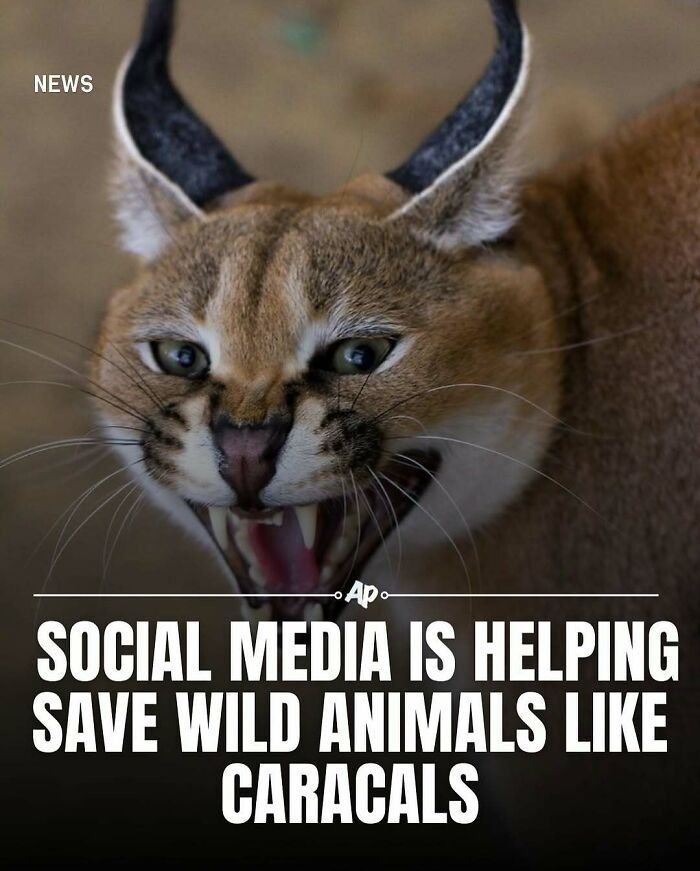
Image credits: an1malpulse
#44
A recent study has revealed the extraordinary capacity for reverse development in the ctenophore, or comb jelly, specifically in the species Mnemiopsis leidyi. Comb jellies seem to use the strategy of aging in reverse as a survival strategy when they are under pressure.
This surprising discovery, led by the University of Bergen, has added fresh perspectives to the field of developmental biology, suggesting that life cycle plasticity might be more prevalent in the animal kingdom than previously assumed.
Traditionally, animal life cycles follow a well-established sequence: birth, growth, reproduction, and death.
Only a few exceptions defy this pattern, such as the “immortal jellyfish” Turritopsis dohrnii, known for its ability to revert from an adult medusa to a polyp stage.
Now, this remarkable club of life-cycle-reversing organisms includes the comb jelly Mnemiopsis leidyi, adding a new chapter to what is understood about animal regeneration and development.

Image credits: an1malpulse
#45
Can you imagine waking up one day, looking in the mirror, and seeing that your tongue had been eaten and replaced by a sinister-looking parasite? That’s exactly what the tongue-eating louse does to fishes. According to Wired, this icky isopod enters through the fish’s gills, chows down on the victim’s tongue, and then firmly plants itself there and becomes a perfectly functional replacement. This is the first and possibly only known case of a parasite becoming a working replacement of its host’s organ in the animal world, according to a 1983 paper. But it gets worse.
In at least one species of tongue-eating louse from Florida, Colt William Cook observed that the parasite is born male, turning female only after it pulls off its tongue-terminating trick. Upon successfully replacing its host’s organ, it mates with one of the other parasites that managed to enter via the fish’s gills. Their brood of all-male offspring then aggressively search for their own victims (the same species of fish), beginning the process once again when they find their target.
Scientists aren’t sure how many of these horrifying creatures are out there. Given that a single study conducted in India yielded 10 new species, this parasite’s actual species diversity could be great enough to leave scientists tongue-tied
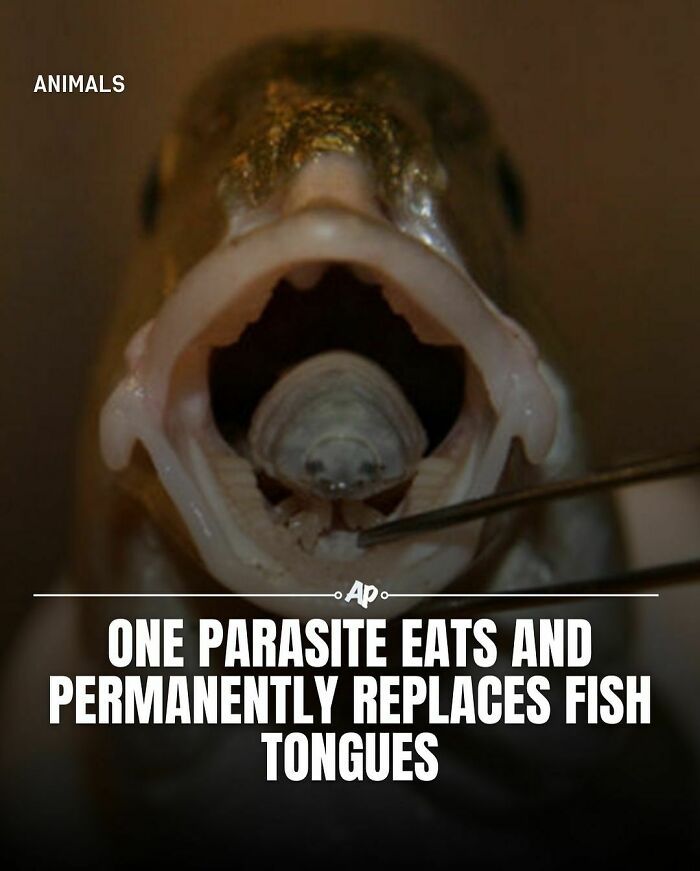
Image credits: an1malpulse
#46
Make sure you check out the video on this one, and not just because we could watch these foxes do their snow-jumping routine all day long. It’s pretty impressive, watching them pad their way across the surface of the snow, then stop, dive headfirst, and come up with a meal. For a long time, we thought they were just listening for their prey. Now, we know they have the equivalent of a state-of-the-art targeting system that relies on their ability to sense Earth’s magnetic field. The details on what’s going on here are still a little hazy, but researchers found that, when foxes did their snow-jump, they aligned themselves in a position that meant they were jumping about 20 degrees northeast of magnetic north. As long as they were facing this direction, they came up with a k*ll about 73 percent of the time. Any other direction, and that dropped off to about 18 percent. You don’t have to like math to know that’s a huge difference, and it’s thought that the fox is relying on a few different senses to pinpoint the oblivious prey hiding beneath the snow. Their directional sense works like a targeting system, relying on their sense of hearing to detect the prey, then switching over to magnetic targeting. Researchers think that foxes are outfitted with cells in their eyes that are sensitive to the planet’s magnetic field. These cells likely reflect a sort of aura onto their eyes, allowing them to calculate the arc of their jumps, and change direction in midair if they need to. Exactly how it works is still unknown, and while they’d be the only mammal that can do this, there are other precedents for the ability. Birds have “magnetite crystals” in their brains that help them navigate, and that’s impressive, too. But Terminator-style targeting? That’s just awesome.

Image credits: an1malpulse
#47
In a remarkable encounter off the coast of Alaska, human scientists had what they describe as a “conversation” with a humpback whale named Twain. Dr. Brenda McCowan from the University of California Davis was at the heart of this unexpected exchange.
Dr. McCowan and her team, known as Whale-SETI, have been studying how humpback whales communicate. They’re aiming to understand whale communication systems to help in the search for life beyond Earth.
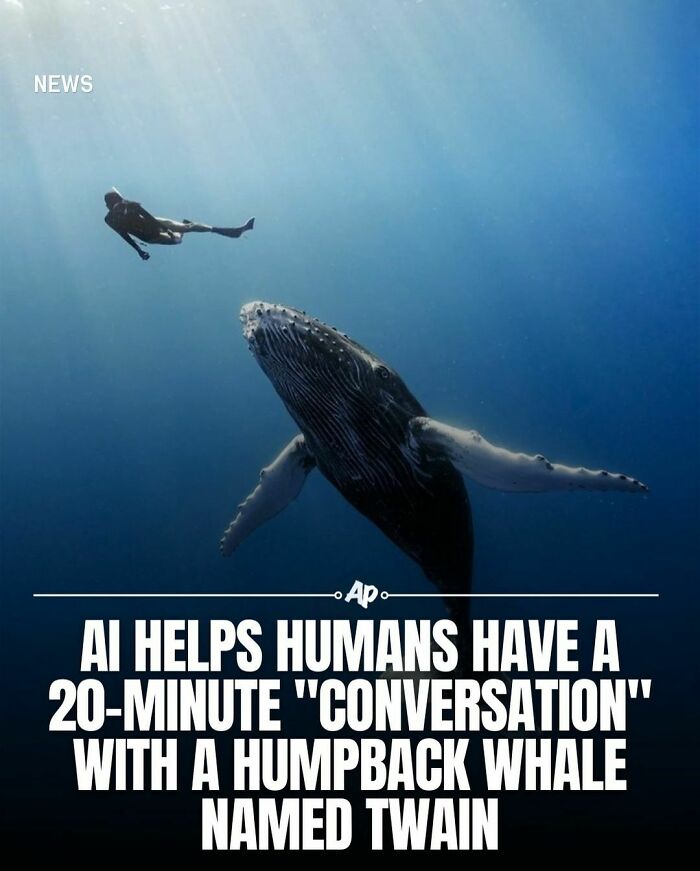
Image credits: an1malpulse
#48
The six tiny eggs were recovered during a field survey of a construction site near Ganzhou in southeastern China in 2021, Chinese state media reported. The fossilized shells, known as the “Ganzhou mini eggs,” were irregularly arranged within a lump of rock, making it hard to determine if they were part of a single nest. The rock dates back roughly 80 million years, to the Cretaceous period (145 million to 66 million years ago).
The smallest egg is 1.1 inches (2.9 centimeters) long, smashing the previous record for the smallest nonavian dinosaur egg, which was held by an egg recovered from Japan. That one was laid by the chicken-size dinosaur Himeoolithus murakamii around 110 million years ago and measured 1.8 inches (4.5 cm), according to Guinness World Records. For comparison, the newly uncovered eggs are around half as long as most chicken eggs.
In a study published Oct. 14 in the journal Historical Biology, researchers revealed that the eggs likely belong to a never-before-seen species of nonavian theropod dinosaur — a group of bipedal, largely predatory dinosaurs such as Tyrannosaurus rex — that they named Minioolithus ganzhouensis. It is currently unclear how large M. ganzhouensis would have grown after hatching.

Image credits: an1malpulse
#49
The critically endangered angular roughshark (Oxynotus centrina) was caught by a commercial trawler off Sazan Island — an uninhabited military island — at a depth of around 656 feet (200 meters).
The shark is the first of its species to be discovered with leucism, a genetic disorder that disrupts melanin production, causing a reduction in pigmentation, scientists report in a new study. Unlike albinism, in which animals completely lack melanin and have red irises, leucistic sharks have normal iris pigmentation even if they appear completely white.
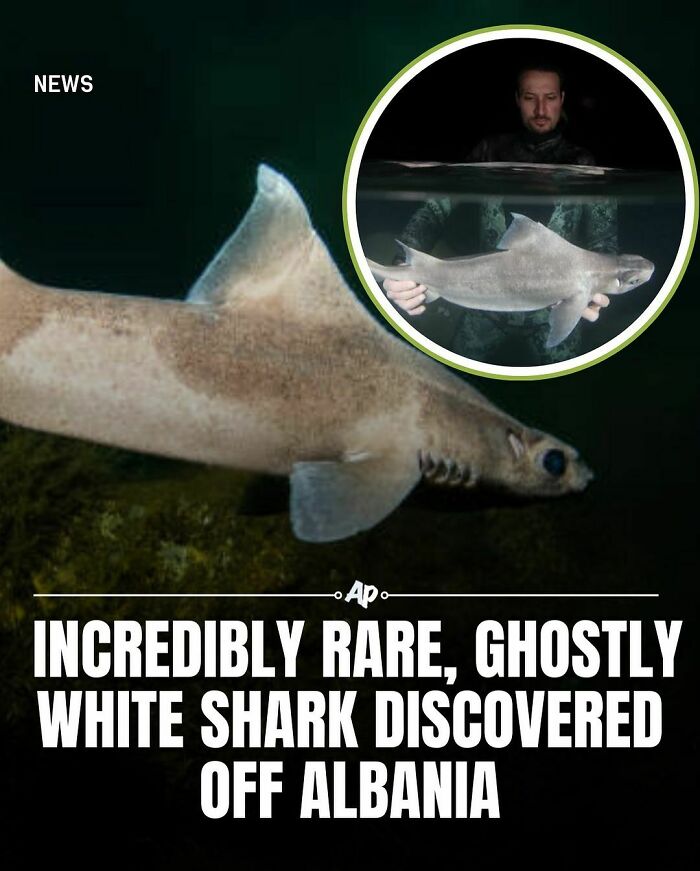
Image credits: an1malpulse
#50
At human drinking establishments, there’s usually at least one dude drowning his sorrows in a glass of scotch. Now, we wouldn’t want to stereotype or anything, but a common theme for those lonely, drunken evenings seems to be romantic rejection. It may be pathetic, but at least it’s something that separates humans from animals, right? Wrong! In fact, it doesn’t even separate humans from fruit flies. Yes, according to National Geographic, a male fruit fly who has not been successful in finding a mate will seek out food that contains alcohol. Males who did find a mate, meanwhile, are perfectly happy hanging out at the barbecue with a bottle of O’Douls.
In case you’re wondering where fruit flies find alcohol, it’s present in just about every rotting, fermenting piece of fruit you leave sitting out on your countertop, which is why fruit flies always seem to find their way to that part of your house. Scientists think the rejected male fruit flies seek out the fruit with the higher alcohol content because they’re looking for some sort of reward that they weren’t able achieve when courting the ladies. As it turns out, alcohol is also useful to fruit flies in other ways — females will lay their eggs in fermenting fruit to protect them from predatory wasps, who don’t have the same love of alcohol (it’s toxic to the teetotaling wasps).
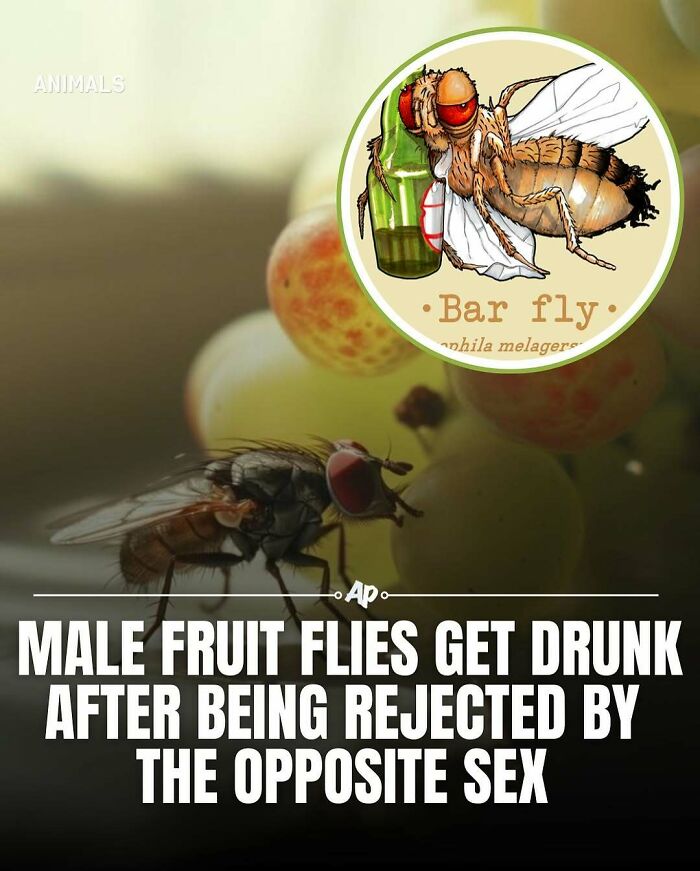
Image credits: an1malpulse
#51
The basking shark is one of the ocean’s most fascinating creatures, known for its massive, open mouth that helps it filter plankton from the water. Despite its intimidating size, this gentle giant poses no threat to humans, showcasing the wonders of marine life and the importance of preserving their habitat
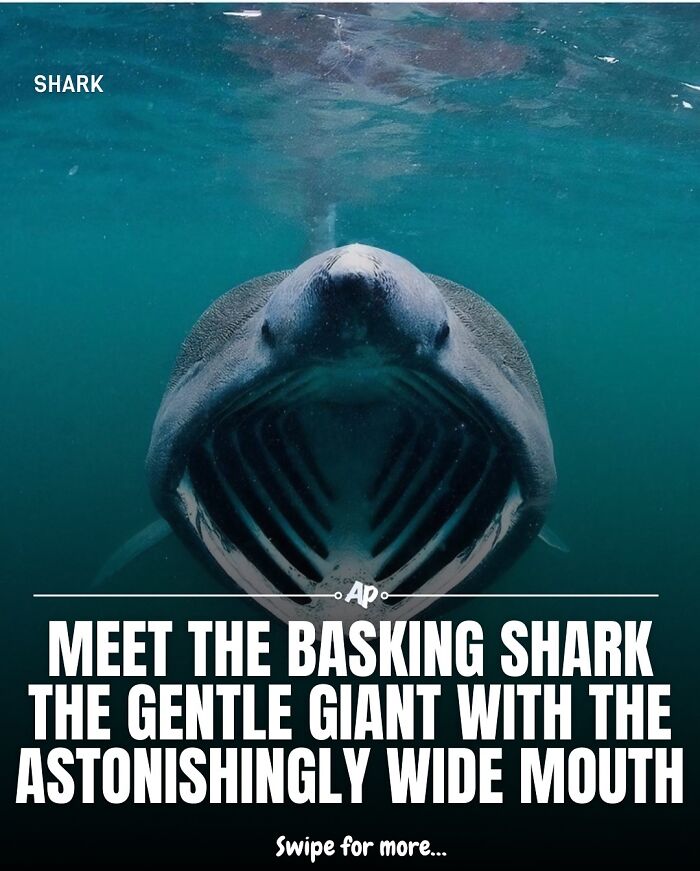
Image credits: an1malpulse
#52
It was the annual Kukur Puja festival in Nepal on Thursday, and dogs across the nation were draped in marigold garlands, marked with celebratory vermillion pigment and presented with overflowing platters of treats.
Like Diwali in India, the five-day Hindu festival of Tihar, being celebrated this week in Nepal, is a festival of lights. Unlike Diwali, Tihar includes the worship of creatures, and Kukur Puja, on its second day, is dedicated to dogs.

Image credits: an1malpulse
#53
What do you do to unwind after a long, hard day at the office? If you said, “take a hot bath,” you’re in good company, because so did about a billion other people, and also this weird species of Japanese monkeys. According to The Japan Times, snow monkeys live in a cold climate, and they spend a lot of time bathing in natural hot springs. The reasons why seem pretty obvious — it’s cold, Japanese snow monkeys don’t have heated bathroom floors, and their butts are naked. But it turns out there’s another advantage to a regular hot bath, which probably won’t surprise you — bathing reduces the snow monkey’s stress level by around 20 percent.
How do researchers know this? They found that monkeys that bathe regularly had lower levels of the stress hormone cortisol than monkeys that didn’t bathe at all. And to arrive at that conclusion, all they had to do was wait for the monkeys to poop, run out and pick it up, then poke around in it in search of evidence. Pretty revealing, right? Well, not because of the monkey-stress-bath-thing, necessarily, but because now we finally know what it is that separates humans from animals. It’s the fact that we’re so ridiculously curious about the world that we will happily dig through another animal’s excrement in search of answers. We can all rest easy with the knowledge that there are no other animals on planet Earth that do that.

Image credits: an1malpulse
#54
The U.S. Fish and Wildlife Service and Arizona Game and Fish Department have confirmed the tragic death of Hope, a Mexican gray wolf (F2979) who had been living west of Flagstaff, Arizona, since June. Hope was found dead on November 7th near Forest Service Road 2058 and East Spring Valley Road.
This devastating loss further imperils the critically endangered Mexican gray wolf species, which struggles to recover with fewer than 260 individuals remaining in the wild.
Authorities and conservation nonprofits are offering a combined reward of $103,500 for information leading to a conviction and arrest in this case. No additional details about Hope’s death have been released as the investigation is ongoing.
Hope was first documented north of Interstate 40 near Flagstaff in the summer of 2024, she was captured, GPS-collared, and released in July. DNA linked her to the Tu Dil Hil pack in the MWEPA. Efforts to translocate her and a companion wolf back to the MWEPA began in October but was haulted when she was found dead. The fate of her companion remains unknown.
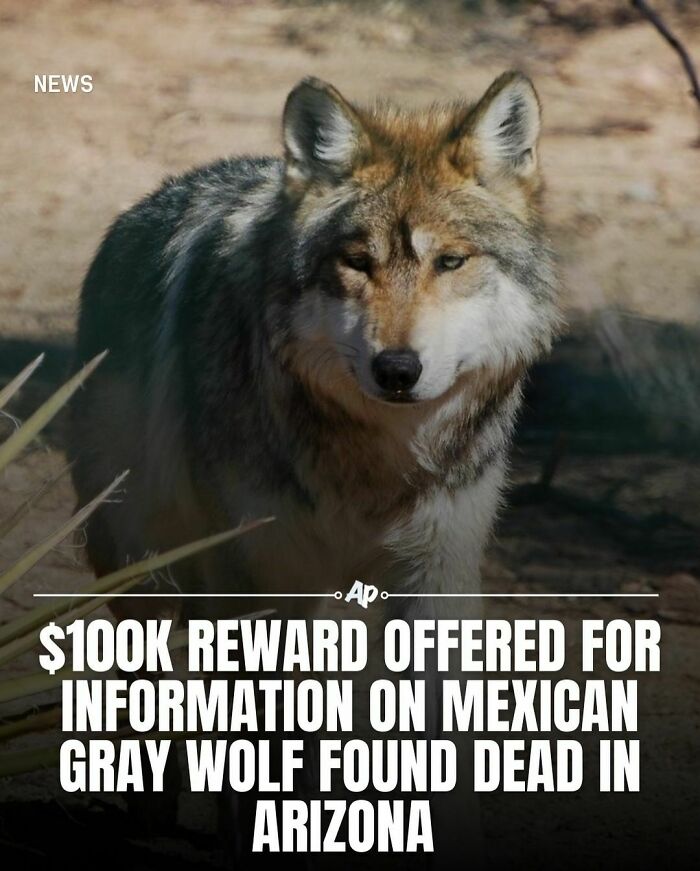
Image credits: an1malpulse
#55
After Henry I’s male heir died in 1120, he spent many years trying to have another. When success looked increasingly unlikely, he made the controversial move of naming his daughter, Matilda, as his heir. He got all his barons to swear loyalty to her and thought the matter settled. In November 1135, Henry followed a day’s hunting with a hearty dinner. But after gorging himself on lampreys, an eel-like fish, he died. The official cause of death: ‘a surfeit of lampreys’. Perhaps inevitably, many barons broke their promise to support Matilda, and a long and brutal civil war erupted.

Image credits: an1malpulse
#56
A white beluga whale named “Hvaldimir,” first spotted in Norway not far from Russian waters with a harness that ignited rumors he may be a Moscow spy, has been found dead.
The Norwegian public broadcaster NRK reported that the whale carcass was found floating at the Risavika Bay in southern Norway Saturday by a father and son who were fishing.
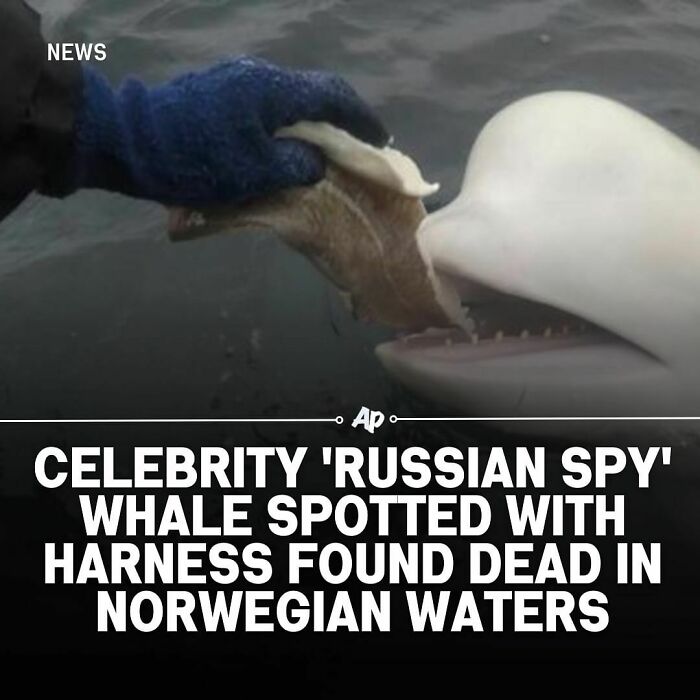
Image credits: an1malpulse
#57
In a major victory for animal welfare, 31 macaque monkeys have been rescued from Indonesia’s last remaining ‘monkey dance training village’ by the Jakarta Animal Aid Network (JAAN), with support from World Animal Protection. The rescued troupe, formerly used in cruel street performances, has been relocated from Cirebon to the JAAN rehabilitation center in Cikole, West Java.
These long-tailed macaques, some as young as eight months old, were horrifically torn from the wild and subjected to months of brutal training designed to force them to dance for money in front of tourists and shoppers.
The abusive training process involved starvation, beatings, and chaining the monkeys by their necks. Forced to wear masks and doll outfits, the animals were made to stand on two legs for hours at a time under the constant threat of choking. When not performing, the monkeys were confined to small, single cages, deprived of adequate space and care.

Image credits: an1malpulse
#58
U.S. Interior Secretary Deb Haaland announced Wednesday that the Apache trout — Arizona’s state fish — has been removed from the federal list of endangered and threatened species following more than five decades of recovery efforts.
Haaland traveled to Arizona for the announcement, which is considered an important conservation success marking the first sportfish and the first trout to be removed from the list.
“This recovery is a testament to the importance of the Endangered Species Act and its tools and resources that are allowing the Interior Department and the federal government to protect vital species in every corner of America,” said Haaland.
She credited joint efforts by federal, state and tribal officials along with $5.1 million from the Biden administration’s Investing in America program

Image credits: an1malpulse
#59
The California Fish and Game Commission unanimously voted to protect western burrowing owls throughout California as a “candidate” species under the California Endangered Species Act.
“After decades of effort to safeguard declining burrowing owl populations in California, the species has finally been afforded interim state protections where they’re most needed — at least for the time being,” said Pamela Flick, California program director with Defenders of Wildlife. “With burrowing owls no longer found in one-third of their former territory statewide, these temporary protections aren’t coming a moment too soon.”
Burrowing owls statewide will be protected while the California Department of Fish and Wildlife conducts a full status review, which could last 12 to 18 months. The commission will then vote on whether to protect the burrowing owls as endangered or threatened under state law.
“At long last, there’s a glimmer of hope for California’s rapidly disappearing burrowing owls, who desperately need protection,” said Jeff Miller, a senior conservation advocate at the Center for Biological Diversity. “Burrowing owls have dwindled and vanished at an alarming rate around the state as their homes are bulldozed for irresponsible sprawl development. I’m thrilled they’re safeguarded for now and look forward to these adorable little owls getting permanent protection.”

Image credits: an1malpulse
#60
A brave mom who was attacked by a grizzly bear while jogging said her 2-year-old daughter was her inspiration to survive.
“I was in the wrong place at the wrong time,” Vanessa Chaput, 24, of Yukon, Canada, told TODAY.com.
On June 30, Chaput was jogging through a paved trail in between Haines Junction and Pine Lake Campground in Ontario, Canada, with her German shepherd, Luna. Chaput said she is familiar with the trail, which runs alongside a highway and is near residential homes. It was 10:30 p.m, but the sun had recently set, so when Chaput rounded a corner, she clearly saw the trouble ahead.
Chaput was face-to-face with three bears.

Image credits: an1malpulse
#61
The research, published Nov. 13 in the journal Biology Letters, suggests that while working dogs may have more complex abilities compared with other breeds, they’re organized into a more compact space in the brain. This differs from what’s seen in evolutionary history in wild mammals, where as brains get bigger relative to body size, cognitive skills tend to become more complex.
“In other groups [of species] relative brain size is indicative of higher cognitive abilities — here we see the opposite,” said Ana Balcarcel, lead author of the new study and an evolutionary biologist at the Montpellier Institute of Evolutionary Sciences in France.

Image credits: an1malpulse
#62
Ever pondered the extraordinary migratory journeys of birds?
These feathered wanderers traverse thousands of kilometers, exhibiting an incredible knack for endurance and navigation that almost seems magical.
In past research, the stars, the Sun and the Earth’s magnetic field have all been implicated as means by which birds find their way to faraway places.
A recent study has shed new light on how birds use the magnetic field to navigate, and the findings challenge previously held beliefs.

Image credits: an1malpulse
#63
On October, 2, 1920, King Alexander of Greece took a stroll through the grounds of the Tatoi estate. Suddenly, a domesticated Barbary Macaque attacked his dog, and when Alexander intervened a second Macaque appeared and bit him. The bite gave him sepsis, and on October, 25, he died. The resultant squabble over his successor drew attention away from war with Turkey, which Greece eventually lost with heavy casualties. Greece simultaneously lost conquered territory in Turkey. According to Winston Churchill, ‘it is perhaps no exaggeration to remark that a quarter of a million persons died of this monkey’s bite’.

Image credits: an1malpulse
#64
Environmental conservation police seized an 11-foot long blind alligator on Thursday that the owner was letting play with human guests, including kids.
Owner Tony Cavallaro had installed an in-ground swimming pool inside of his home in Hamburg, New York where he’d been keeping the 30 year-old alligator on an expired permit.
The owner “allegedly allowed members of the public to get into the water to pet the unsecured alligator,” according to a press release from the New York State Department of Environmental Conservation. Public contact with such an animal is prohibited by DEC guidelines.

Image credits: an1malpulse
#65
Police said a woman who was found in a remote Australian mountain range after going missing for almost two weeks was “dazed and unwell” but alive after suffering a snake bite in remote wilderness.
New South Wales Police said in a statement that Lovisa “Kiki” Sjoberg, 48, was found just before 5 p.m. local time Sunday in the Snowy Mountains region of Kosciuszko National Park, after a huge multi-agency search that involved two helicopters and dog teams.
She was last seen driving a hire car in the national park on Oct. 15. The search began when the hire company told police the vehicle had not been moved in six days and the lease had ended.
Monaro Police District Superintendent Toby Lindsay told a news conference Monday, reported by the Australian Broadcasting Corporation, that the woman was “dazed and injured” and “quite unwell.”
“She advises she was bitten by a copperhead snake four days before being found and also rolled her ankle and she was suffering from dehydration,” he said. “We held grave concerns for the missing woman and [are] very glad she’s been found safe and reasonably well.”

Image credits: an1malpulse
#66
The legendary “doom fish” has returned to California.
A long, ribbon-shaped oarfish, rarely seen and believed to signal disaster, has washed up on California’s shores for the second time this year.
PhD candidate Alison Laferriere from the Scripps Institution of Oceanography at UC San Diego discovered the nearly 10-foot-long oarfish on a beach in Encinitas, in southern California, last week.
Oarfish are elusive creatures that dwell in the deep ocean — often as far as 3,300 feet below the surface — in the mesopelagic zone, a dark region beyond the reach of sunlight.

Image credits: an1malpulse
#67
If you’ve ever wondered what it would be like to encounter a vicious Velociraptor — or a version closer to the man-sized “Jurassic Park” ones than the turkey-sized, scientifically accurate ones — then look no further than the southern cassowary. According to the official website of the Queensland Government, it is the “heaviest flightless bird” in Australia, and the only one among the three known cassowary species found in the country. It also happens to be the Guinness World Record-holder for the title of “most dangerous bird,” and rightly so: It can k*ll you with a single, well-aimed kick. Standing over 6 feet tall, the southern cassowary sports bristly black plumage, a dark blue neck, a lighter shade of blue on its head, and two red skin flaps hanging from its neck. On top of its head sits a hollow, crest-like casque, making this bird a truly striking sight. You’ll want to stay out of striking range, though, as it also possesses strong, muscular legs and three-toed feet with sharp claws. Its inside claw is easily the most dangerous one, growing up to 5 inches long. In one swift, powerful motion, it can cut its target wide open, damaging the organs and causing the victim to bleed out. Fortunately, the cassowary isn’t known to be aggressive and will only attack if it feels the need to defend itself, its chicks, or its nest (via Scientific American).

Image credits: an1malpulse
#68
A Colorado man who was placed on life support after he was bitten by his pet Gila monster died of complications from the desert lizard’s venom, an autopsy report obtained by The Associated Press on Friday confirmed.
The report also found that heart and liver problems were significant contributing factors in Christopher Ward’s death.
Ward, 34, was taken to a hospital shortly after being bitten by one of his two pet Gila monsters on Feb. 12. His death less than four days later is believed to be the first from a Gila monster in the U.S. in almost a century.
The autopsy, conducted by the Jefferson County Coroner’s Office on Feb. 18, said Ward was bitten for four minutes and wavered in and out of consciousness for about two hours before seeking medical attention. He suffered multiple seizures and acute respiratory failure at the hospital.
Ward’s girlfriend handed over the lizard named Winston and another named Potato to an animal control officer and other officers in the Denver suburb of Lakewood the day after the bite. She told police she had heard something that “didn’t sound right” and entered a room to see Winston latched onto Ward’s hand, according to the animal control officer’s report.
She told officers Ward “immediately began exhibiting symptoms, vomiting several times and eventually passing out and ceasing to breathe,” according to the report. She also said she and Ward bought Winston at a reptile exhibition in Denver in October and Potato from a breeder in Arizona in November. Told that Gila monsters were illegal in Lakewood, the woman told officers she wanted them out of her house as soon as possible, according to the report.

Image credits: an1malpulse




























